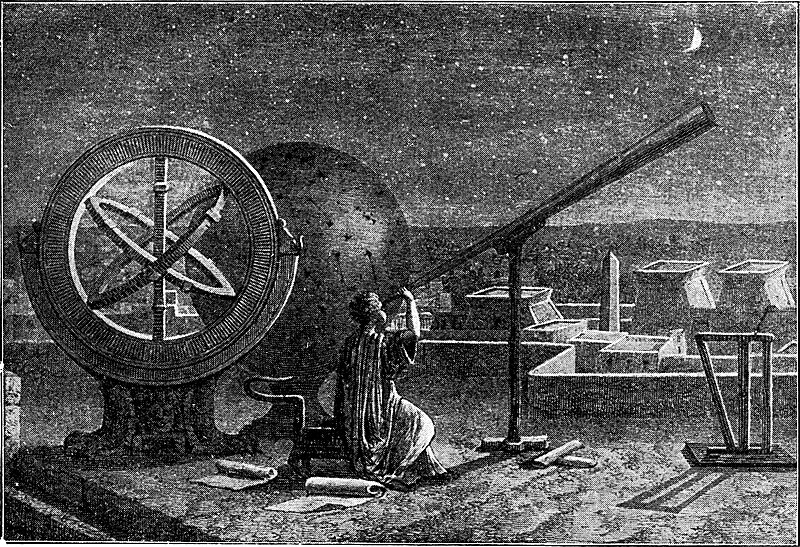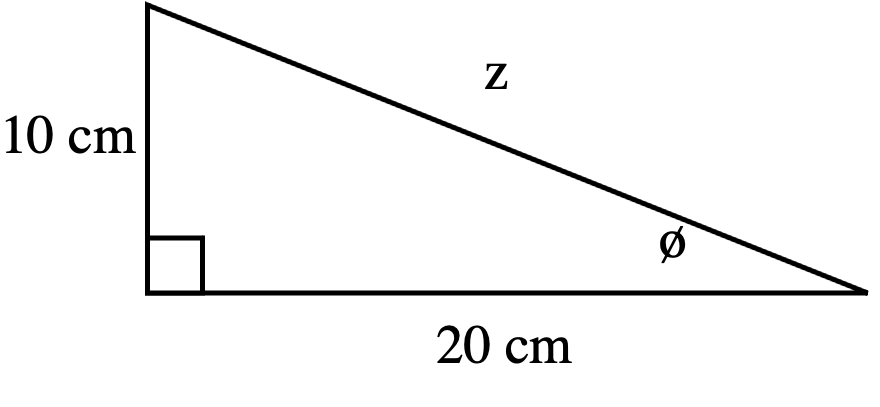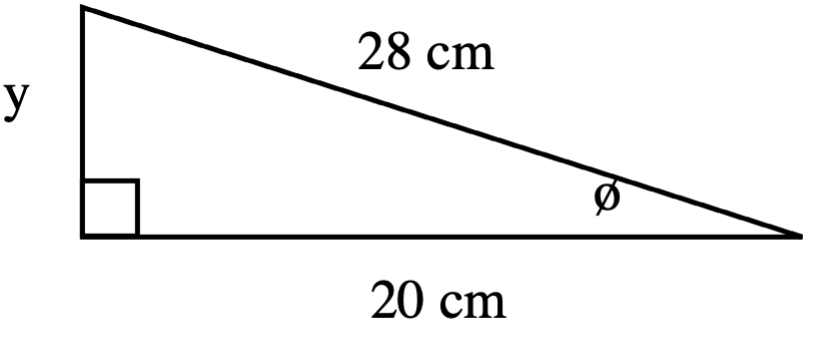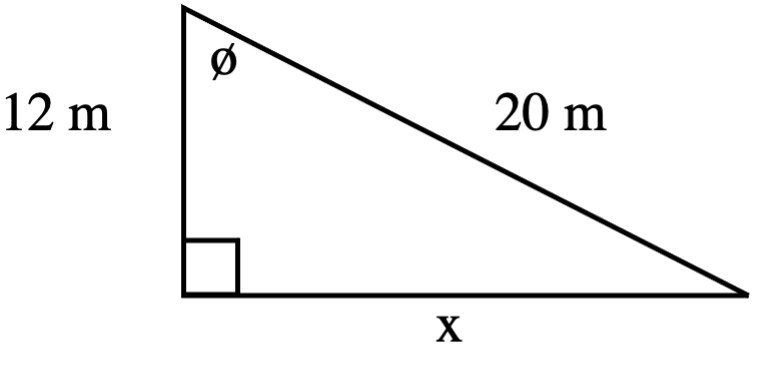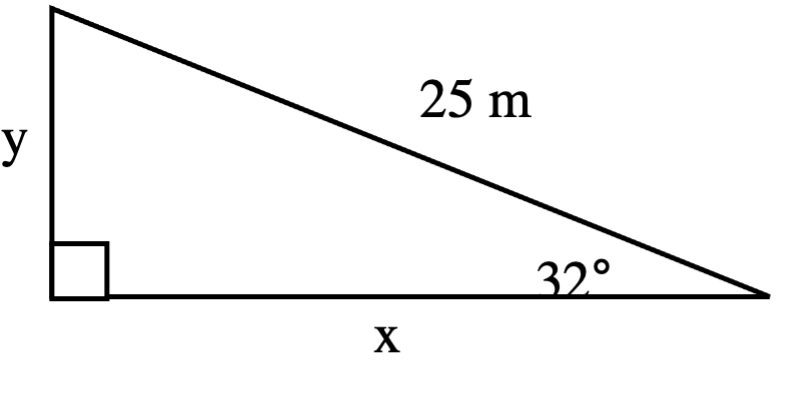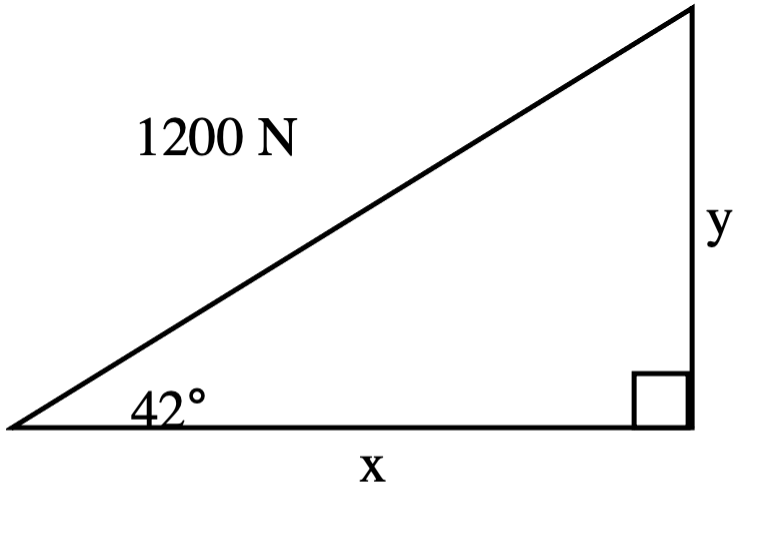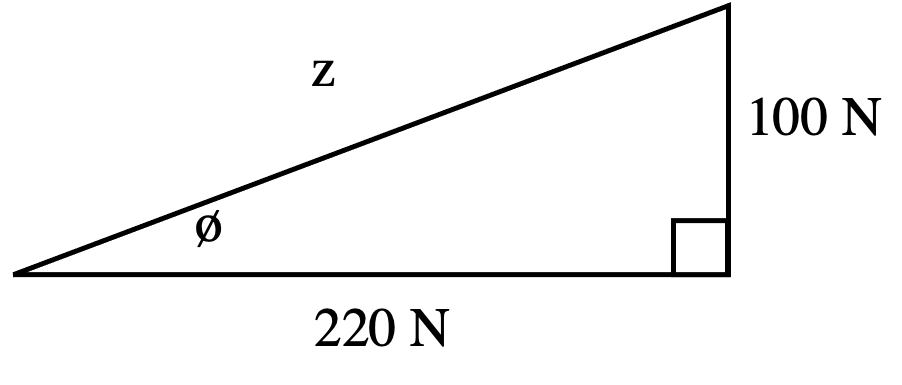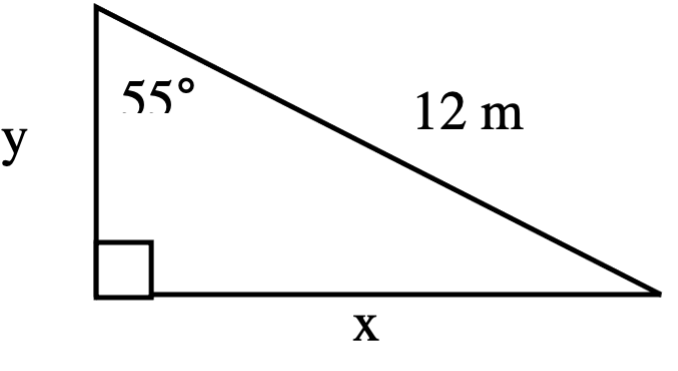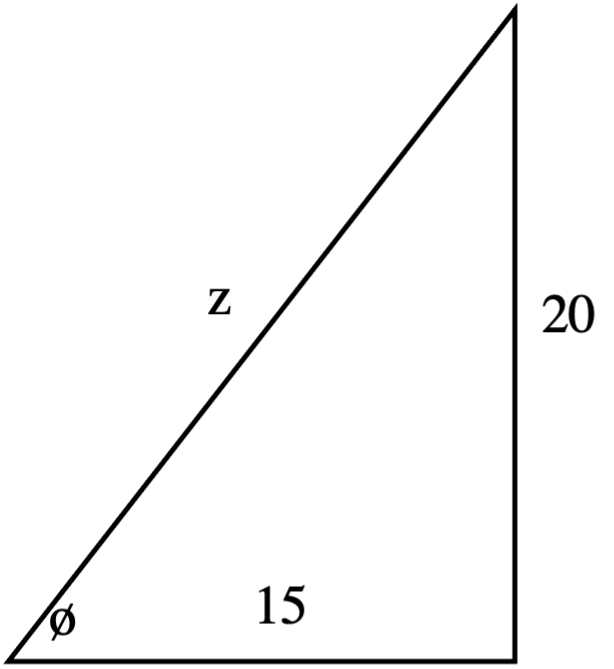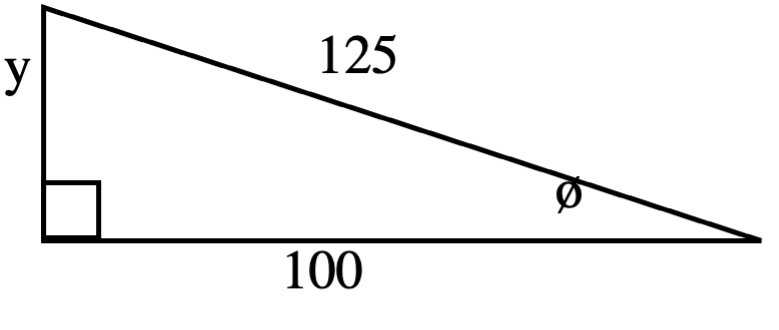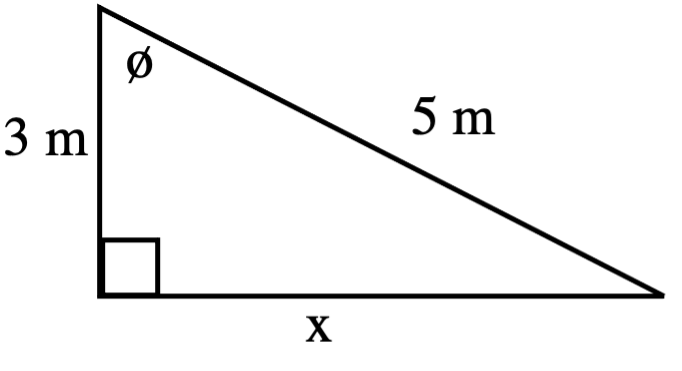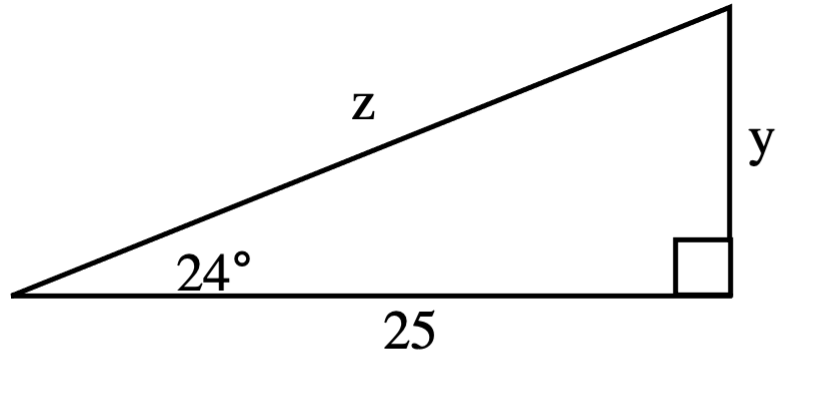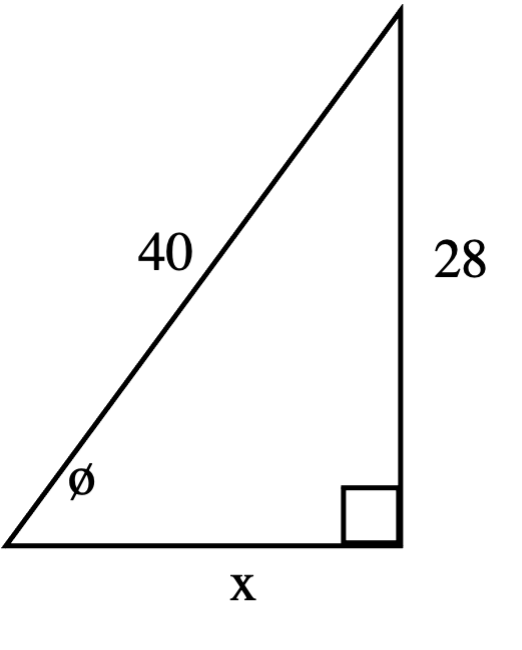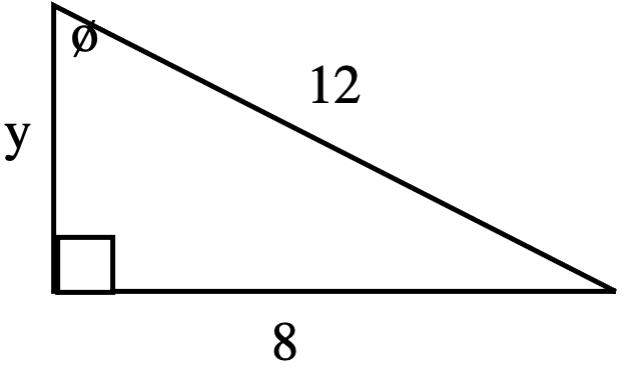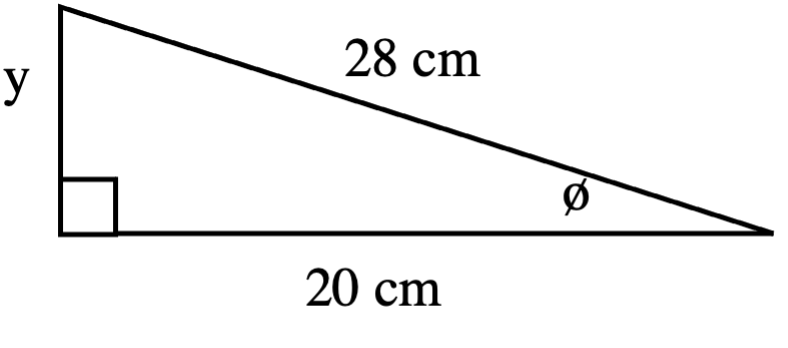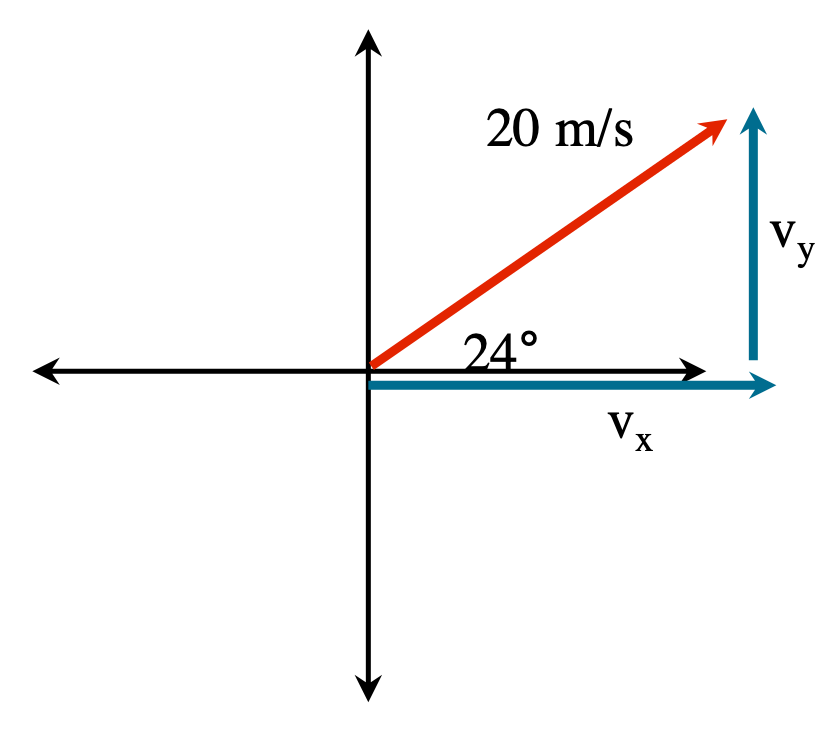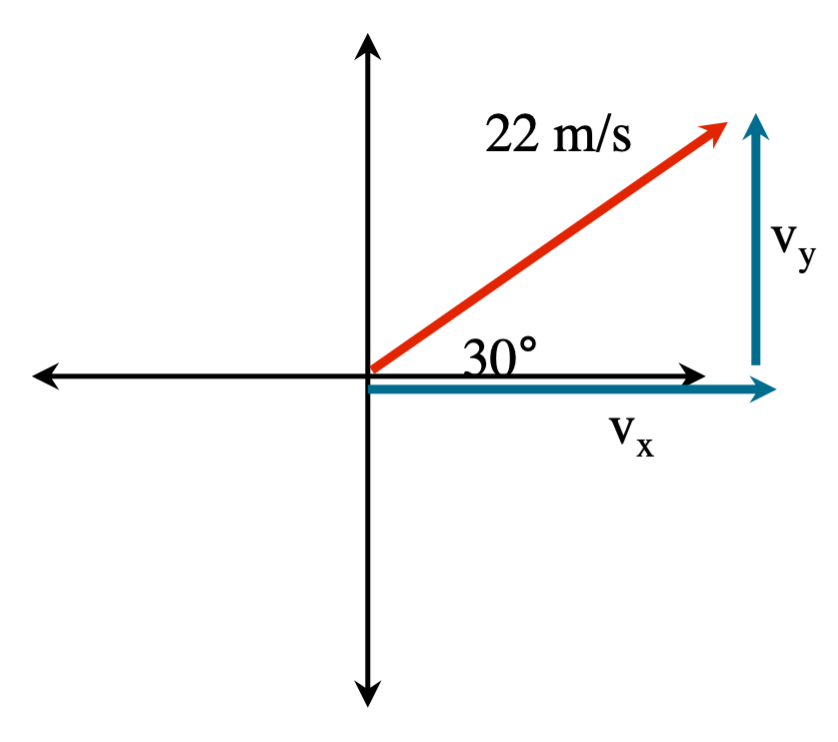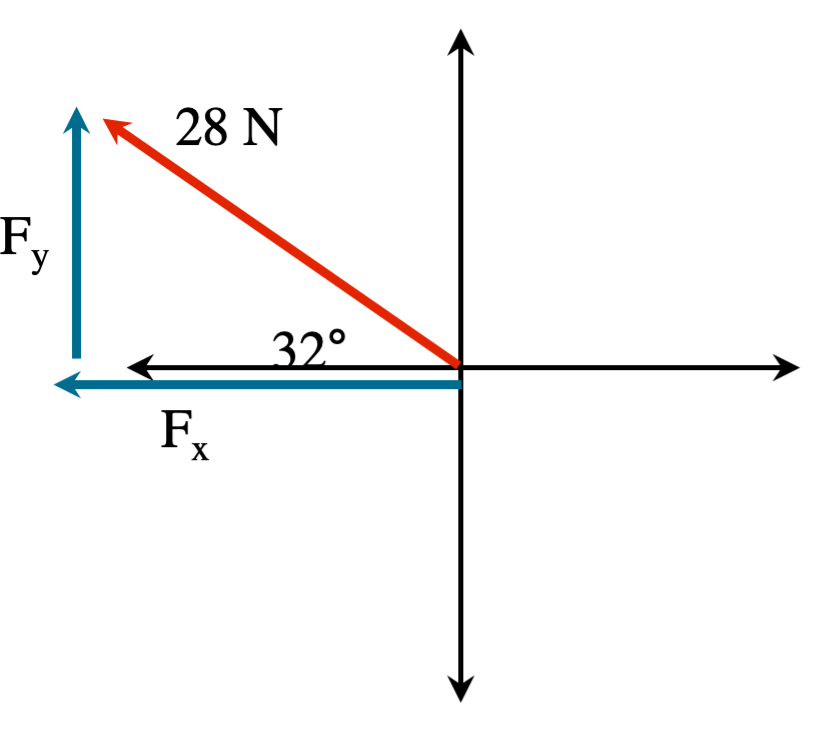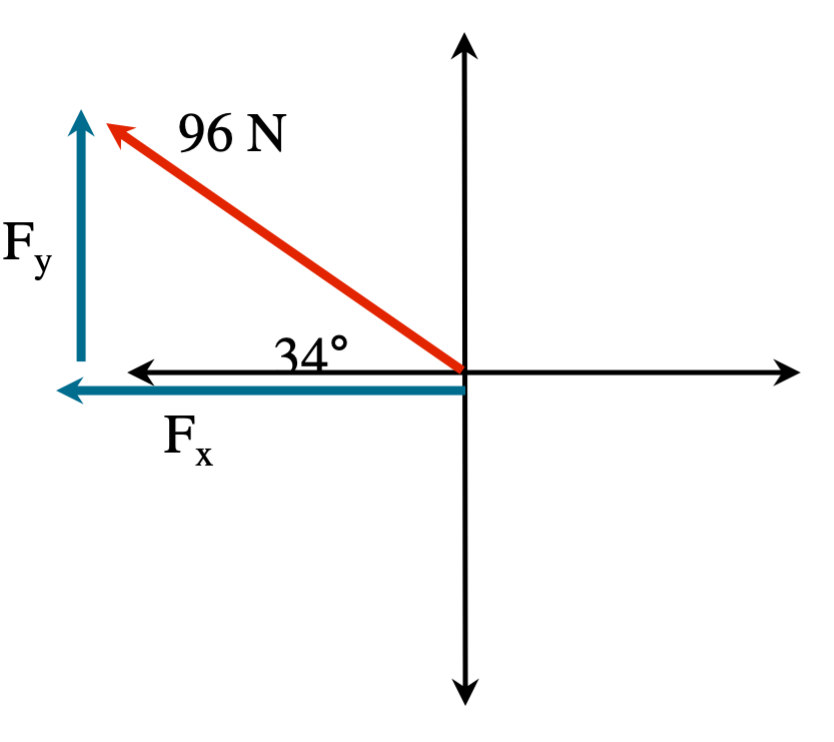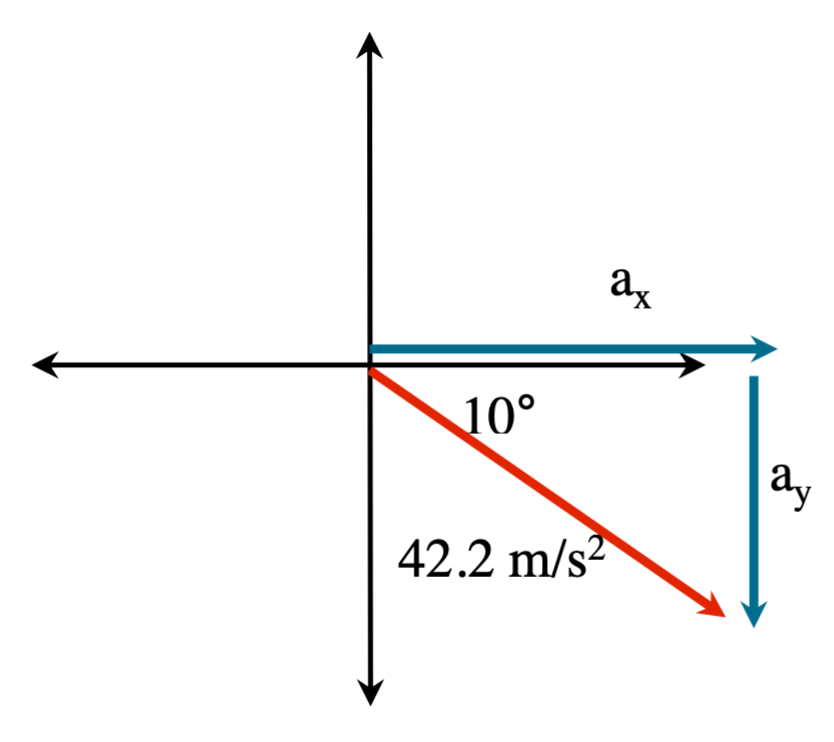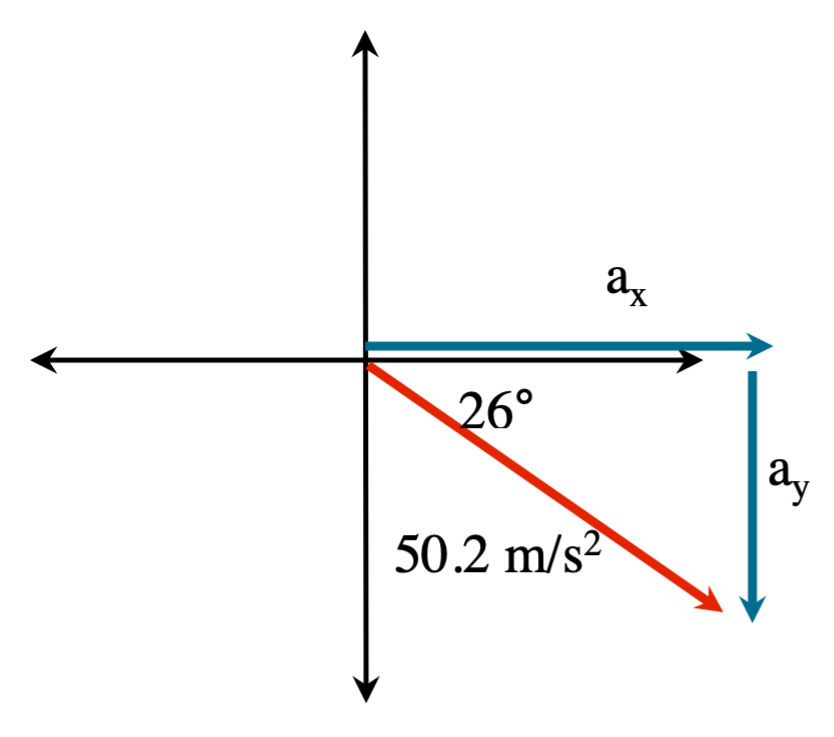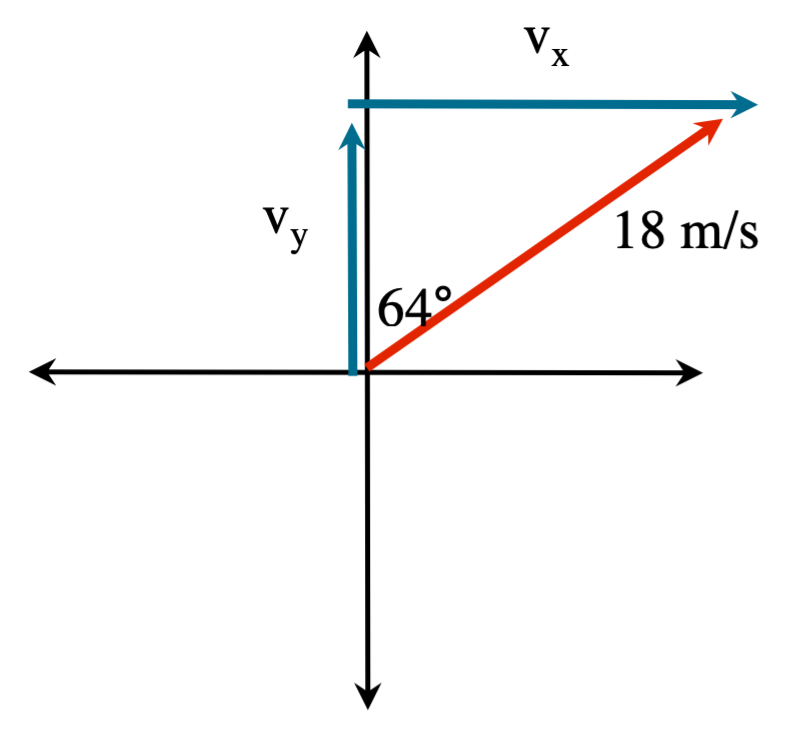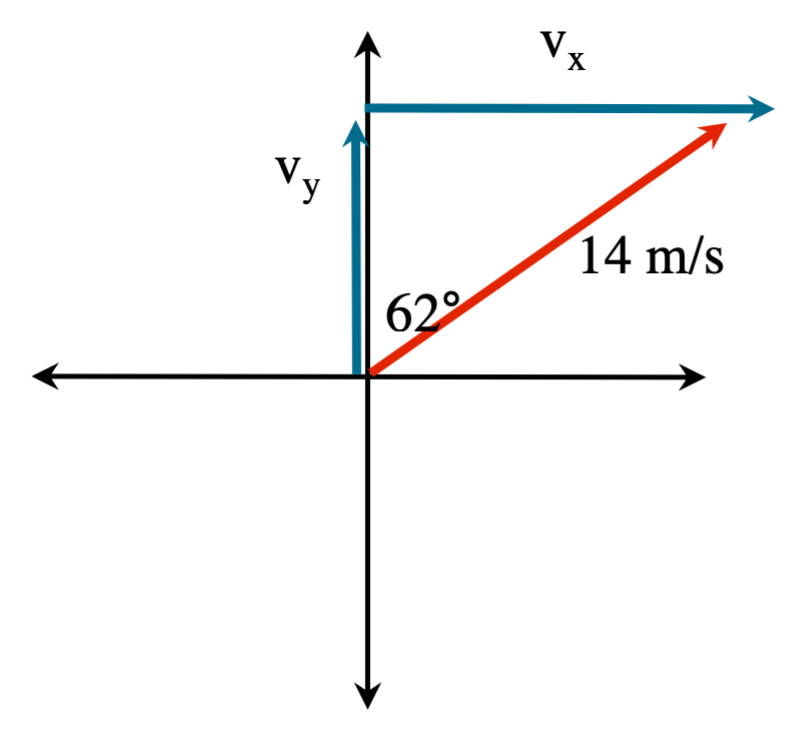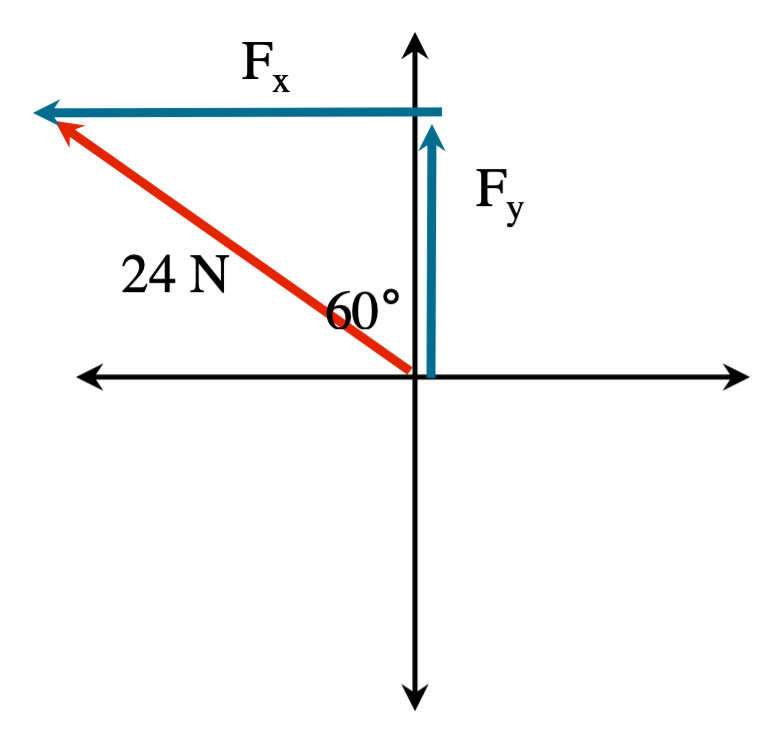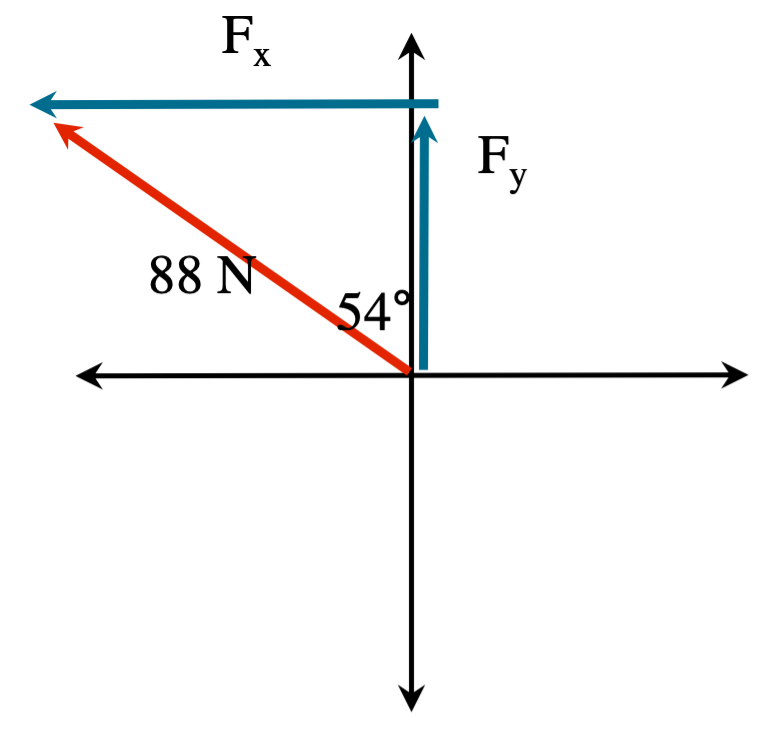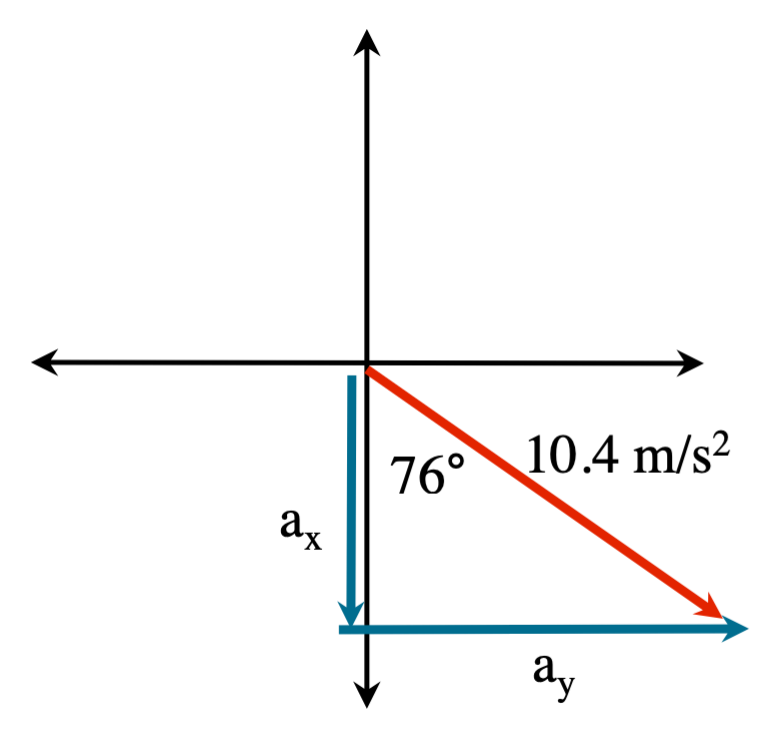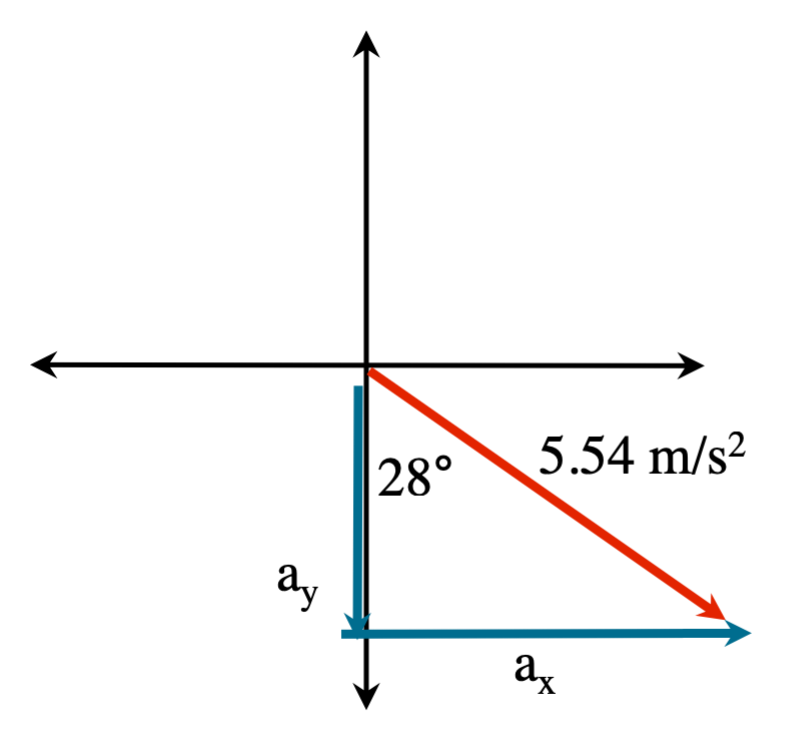7 Equilibrium & Newton’s First Law
Key Takeaways
- Extra Help: Newton’s First Law
- Extra Help: Equilibrium and Statics
Equations Introduced and Used for this Topic: (All equations can be written and solved as both scalar and vector and all equations are generally solved as vectors)
- [latex]\sum F_{x, y, z} = 0 \text{ N}[/latex]
- [latex]T = r \times F[/latex]
- [latex]T_{\text{clockwise}} = T_{\text{counter-clockwise}}[/latex]
- [latex](m_1 + m_2) x_{\text{cm}} = m_1 x_1 + m_2 x_2[/latex]
Where…
- [latex]T[/latex] is the torque, measured in newton-metres (Nm)
- [latex]F[/latex] is force, measured in newtons (N)
- [latex]r[/latex] is the length of the lever-arm measured in metres (m)
- [latex]m_1[/latex] and [latex]m_2[/latex] are the masses of two bodies, measured in kilograms (kg)
- [latex]x_{\text{cm}}[/latex], [latex]x_1[/latex], and [latex]x_2[/latex] are the distances, measured in metres (m)
- ø is the angle given for the triangle and is generally between the adjacent side and the hypotenuse with the angle measured in degrees (be careful to make sure that the calculator is not working in gradients or radians).
- Hypotenuse is the longest side in a right triangle and is opposite to the 90° angle.
- Opposite is the side that is opposite to the angle that you are given.
- Adjacent is the side that is beside the angle you are given.
The Trigonometric Functions:
- [latex]\text{sine ø } = \dfrac{\text{opposite}}{\text{hypotenuse}}[/latex]
- [latex]\text{cosine ø } = \dfrac{\text{adjacent}}{\text{hypotenuse}}[/latex]
- [latex]\text{tangent ø } = \dfrac{\text{opposite}}{\text{adjacent}}[/latex]

7.1 Right Angle Trigonometric Functions
Trigonometry, a term derived from the Greek trigonon (triangle) and metron (measure) has known historical roots dating back 4000 years to writings found in Egyptian and Babylonian mathematics and astronomical records. Indian astronomers were using trigonometry over 2600 years ago and that widespread usage by Islamic and Chinese scientists was common at least 1500 years prior.
The study of trigonometry returned to European nations in the Renaissance in translations of Arabic and Greek writings. Modern trigonometry is credited as reaching its current form through the works of Leonard Euler (1707-1783), who is considered to be one of the greatest mathematicians in history and had worked in nearly every area of mathematics and physics. Modern notation used in trigonometry comes directly from Euler’s writings, as are many other currently used notations in mathematics and physics. A list of Euler’s achievements is extensive as well as his writings that have been collected in 92 volumes, making him one of the most prolific writers in mathematics history.
Introductory trigonometry is based on identifying the similarities between identical right angled (one angle is 90°) of different sizes. If the angles of a triangle are identical then all of these triangles are simply larger or smaller copies of each other. In all of the cases shown above, if you take any two sides of any triangle shown and divide them by each other, that number will be exactly the same.
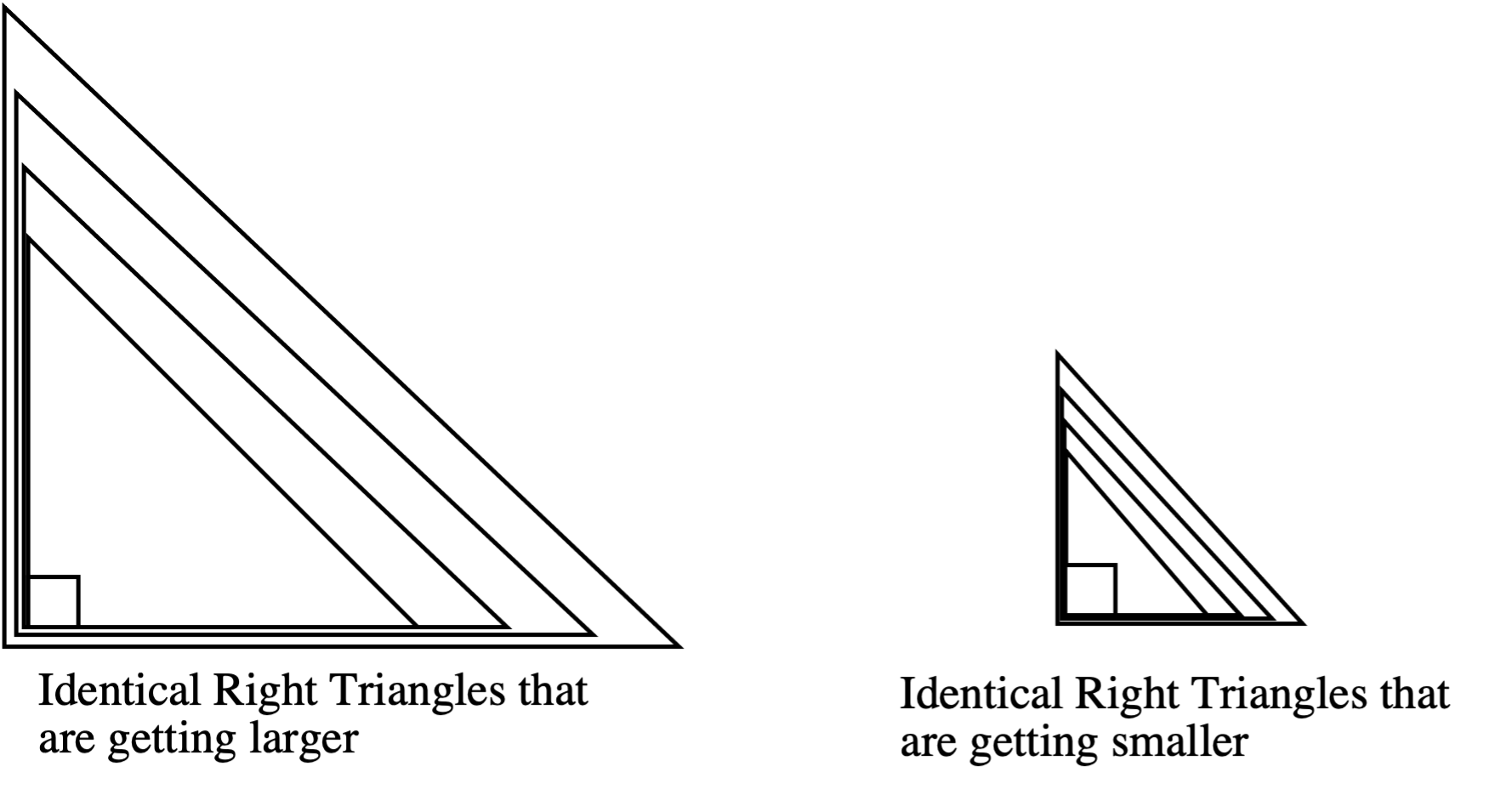
These triangle ratios have defined names:
- [latex]\text{sine } = \dfrac{\text{opposite}}{\text{hypotenuse}}[/latex]
- [latex]\text{cosine } = \dfrac{\text{adjacent}}{\text{hypotenuse}}[/latex]
- [latex]\text{tangent } = \dfrac{\text{opposite}}{\text{adjacent}}[/latex]
You often see these equations shortened to:
- [latex]\text{sin } = \dfrac{\text{opp}}{\text{hyp}}[/latex]
- [latex]\text{cos } = \dfrac{\text{adj}}{\text{hyp}}[/latex]
- [latex]\text{tan } = \dfrac{\text{opp}}{\text{adj}}[/latex]
and memorized as: SOH – CAH – TOA
Defining the sides of a triangle follows a set pattern:
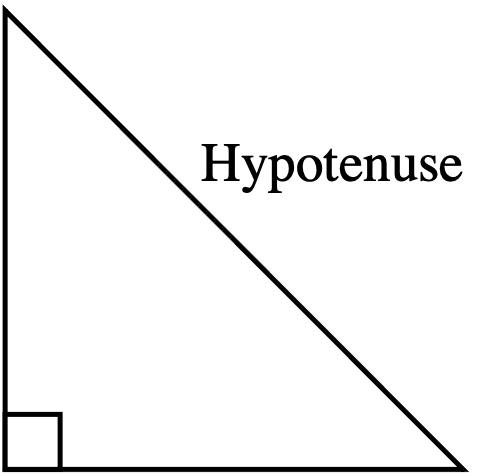
- The side of a triangle that is opposite to the right angle is called the hypotenuse.
- The opposite and adjacent sides are then defined by the angle you are going to work with. One of the sides will be opposite this angle and the other side will be adjacent to this side.
For example: The following sides are defined by the right angle and the angle you are going to work with ø. You will have to define the adjacent and opposite sides for every right triangle you work with.

The other right angled trigonometric rations are the reciprocals of Sine, Cosine and Tangent:
- [latex]\text{Cosecant } = \dfrac{1}{\text{Sine}}[/latex]
- [latex]\text{Secant } = \dfrac{1}{\text{Cosine}}[/latex]
- [latex]\text{Cotangent } = \dfrac{1}{\text{Tangent}}[/latex]
or formally defined as:
- [latex]\text{Cosecant } = \dfrac{\text{hypotenuse}}{\text{opposite}}[/latex]
- [latex]\text{Secant } = \dfrac{\text{hypotenuse}}{\text{adjacent}}[/latex]
- [latex]\text{Cotangent } = \dfrac{\text{adjacent}}{\text{opposite}}[/latex]
You often see these equations shortened to:
- [latex]\text{Csc } = \dfrac{\text{hyp}}{\text{opp}}[/latex]
- [latex]\text{Sec} = \dfrac{\text{hyp}}{\text{adj}}[/latex]
- [latex]\text{Cot } = \dfrac{\text{adj}}{\text{opp}}[/latex]
These reciprocal trigonometric functions are commonly used in calculus, specifically in integration and when working with polar coordinates. Anyone taking higher levels of mathematics will encounter these reciprocal trigonometric functions.
Using the Pythagorean theorem for 30°, 45° and 60° right angle triangles, you can get the exact values of the trigonometric relationship (and the reciprocal values). It is standard to see exams where students are required to draw these 30°, 45° and 60° right angle triangles and use the side lengths to generate exact values.
Another common sight is to see trigonometric tables being used as approximations of the trig ratios of standard angles from 1° to 90°. For these tables you just choose the value that lines up the trigonometric function you wish to use with the angle that you are using. Basic scientific calculators have essentially made these tables obsolete.
Standard Reference Angles:
- [latex]\sin 30^{\circ} = \dfrac{1}{2}[/latex]
- [latex]\cos 30^{\circ} = \dfrac{\sqrt{3}}{2}[/latex]
- [latex]\tan 30^{\circ} = \dfrac{1}{\sqrt{3}}[/latex]
- [latex]\sin 45^{\circ} = \dfrac{1}{\sqrt{2}}[/latex]
- [latex]\cos 45^{\circ} = \dfrac{1}{\sqrt{2}}[/latex]
- [latex]\tan 45^{\circ} = 1[/latex]
- [latex]\sin 60^{\circ} = \dfrac{\sqrt{3}}{2}[/latex]
- [latex]\cos 60^{\circ} = \dfrac{1}{2}[/latex]
- [latex]\tan 60^{\circ} = \dfrac{\sqrt{3}}{1}[/latex]

Example 7.1.1
Find the values that correspond to the following trigonometric functions and angles:
- [latex]\sin 19^{\circ} = x[/latex]
- [latex]\cos 67^{\circ} = y[/latex]
- [latex]\tan 38^{\circ} = z[/latex]
Solution
- [latex]x = 0.326[/latex]
- [latex]y = 0.391[/latex]
- [latex]z = 0.781[/latex]
It is also possible to work in reverse, i.e.: given the trigonometric ration of two sides, you can find the angle that you are working with.
Example 7.1.2
Find the angles that correspond to the following trigonometric values:
- [latex]\sin ø = 0.829[/latex]
- [latex]\cos ø = 0.940[/latex]
- [latex]\tan ø = 3.732[/latex]
Solution
- ø = 56°
- ø = 20°
- ø = 75°
Sometimes you do not have a value that matches up. For these cases you choose the value that is closest to what you have.
Example 7.1.3
Find the angles that are closest to the following trigonometric values:
- [latex]\sin ø = 0.297[/latex]
- [latex]\cos ø = 0.380[/latex]
- [latex]\tan ø = 0.635[/latex]
Solution
- ø = 17°
- ø = 68°
- ø = 32°
Example 7.1.4
Solve for the unknown side in the following triangle.
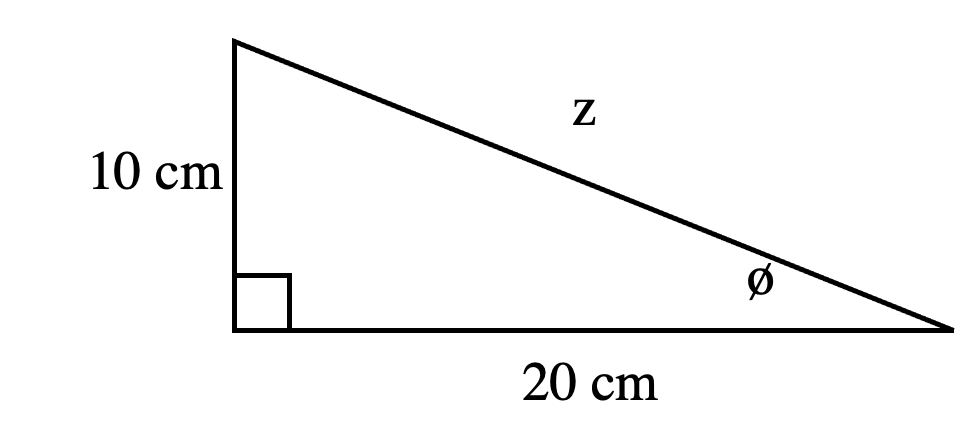
Solution
[latex]\begin{align}z &= \sqrt{10^2+20^2} \\ &=22.361 \\ &= 22 \text{ cm} \end{align}[/latex]
[latex]angle \ ø = \tan ^{-1}\left(\dfrac{10}{20} \right) = 27^{\circ}[/latex]
Example 7.1.5
Solve for the unknown sides in the following triangle.
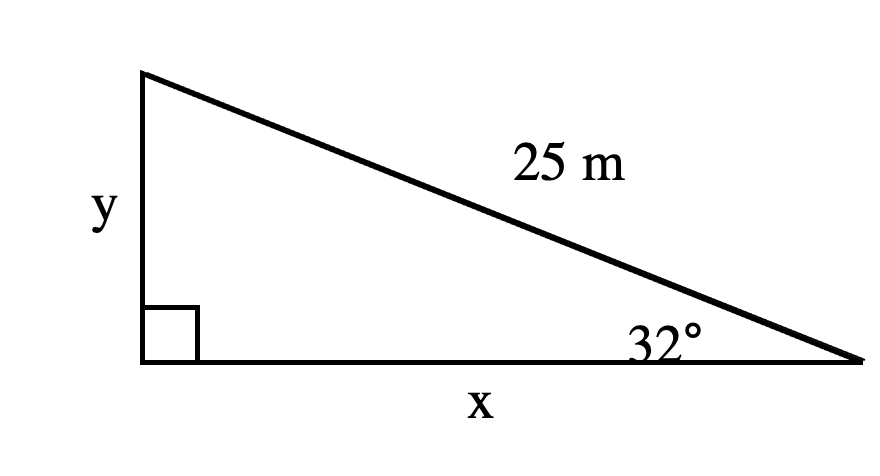
Solution
[latex]y = (25 \text{ m})(\sin 32^{\circ}) = 13 \text{ m}[/latex]
[latex]x =(25 \text{ m})(\cos 32^{\circ}) = 21 \text{ m}[/latex]
To find trigonometric tables, go to Appendix A: Trigonometric Tables.
Exercise 7.1
Find the value of each of the following trigonometric functions using your scientific calculator to 6 digits.
- [latex]\sin 48^{\circ}[/latex]
- [latex]\sin 29^{\circ}[/latex]
- [latex]\cos 25^{\circ}[/latex]
- [latex]\cos 61^{\circ}[/latex]
- [latex]\tan 11^{\circ}[/latex]
- [latex]\tan 57^{\circ}[/latex]
- [latex]\sin 11^{\circ}[/latex]
- [latex]\cos 57^{\circ}[/latex]
Use your scientific calculator to find each angle to the nearest hundredth of a degree.
- [latex]\sin ø = 0.4848[/latex]
- [latex]\sin ø = 0.6293[/latex]
- [latex]\cos ø =0.6561[/latex]
- [latex]\cos ø =0.6157[/latex]
- [latex]\tan ø = 0.6561[/latex]
- [latex]\tan ø = 0.1562[/latex]
- [latex]\sin ø =0.6561[/latex]
- [latex]\cos ø =0.1562[/latex]
Solve for all unknowns in the following right triangles.
7.2 Vector Resolution Into Components
Through practice you will be able to quickly resolve angled vectors using right triangle trigonometry. For example, given a force vector of 100 N angled at 42° from the horizontal, you can break it up into vertical and horizontal components using the sine and cosine functions. In this instance the vector components are as follows:
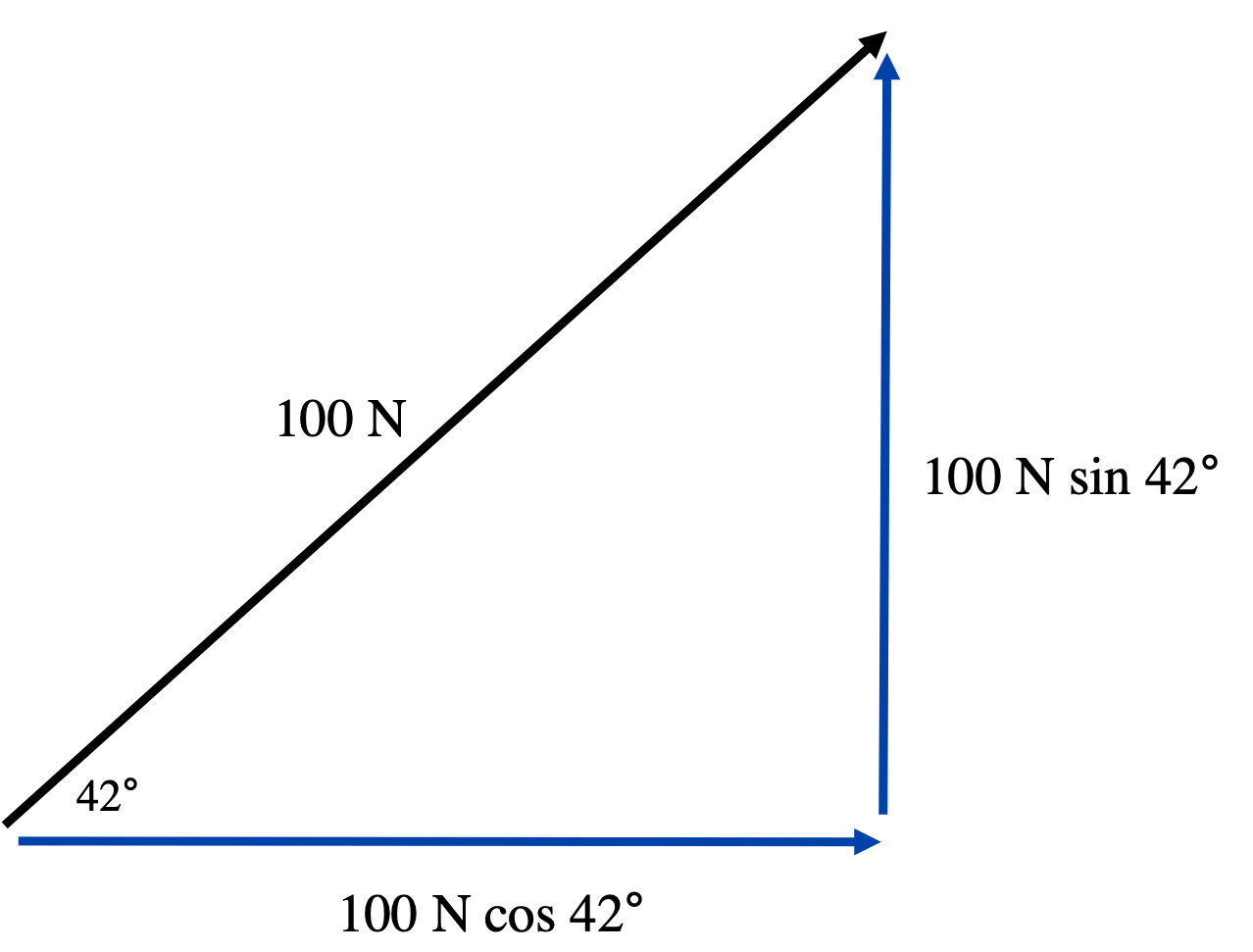
Quick Resolution:
- [latex]F = 100 \text{ N}[/latex]
- [latex]F_x = 100 \text{ N } \cos 42^{\circ}[/latex] (≈ 74 N)
- [latex]F_y = 100 \text{ N } \sin 42^{\circ}[/latex] (≈ 70 N)
A more detailed resolution is:
- [latex]F_x[/latex]: [latex]\cos 42^{\circ} = \dfrac{F_x}{100 \text{ N}}[/latex] which, when isolated, leaves us with [latex]F_x = 100 \text{ N } \cos 42^{\circ}[/latex]
- [latex]F_y[/latex]: [latex]\sin 42^{\circ} = \dfrac{F_y}{100 \text{ N}}[/latex] which, when isolated, leaves us with [latex]F_y = 100 \text{ N } \sin 42^{\circ}[/latex]
When the vector magnitude is known, then the opposite side vector is the sine of the vector angle and the adjacent side vector is the cosine of the vector angle.
When both vector components are known, the angle of the resultant vector can be found using the tangent function and the magnitude of the vector by using the Pythagorean Theorem. For this, one generally uses a more traditional approach. Consider the following example:
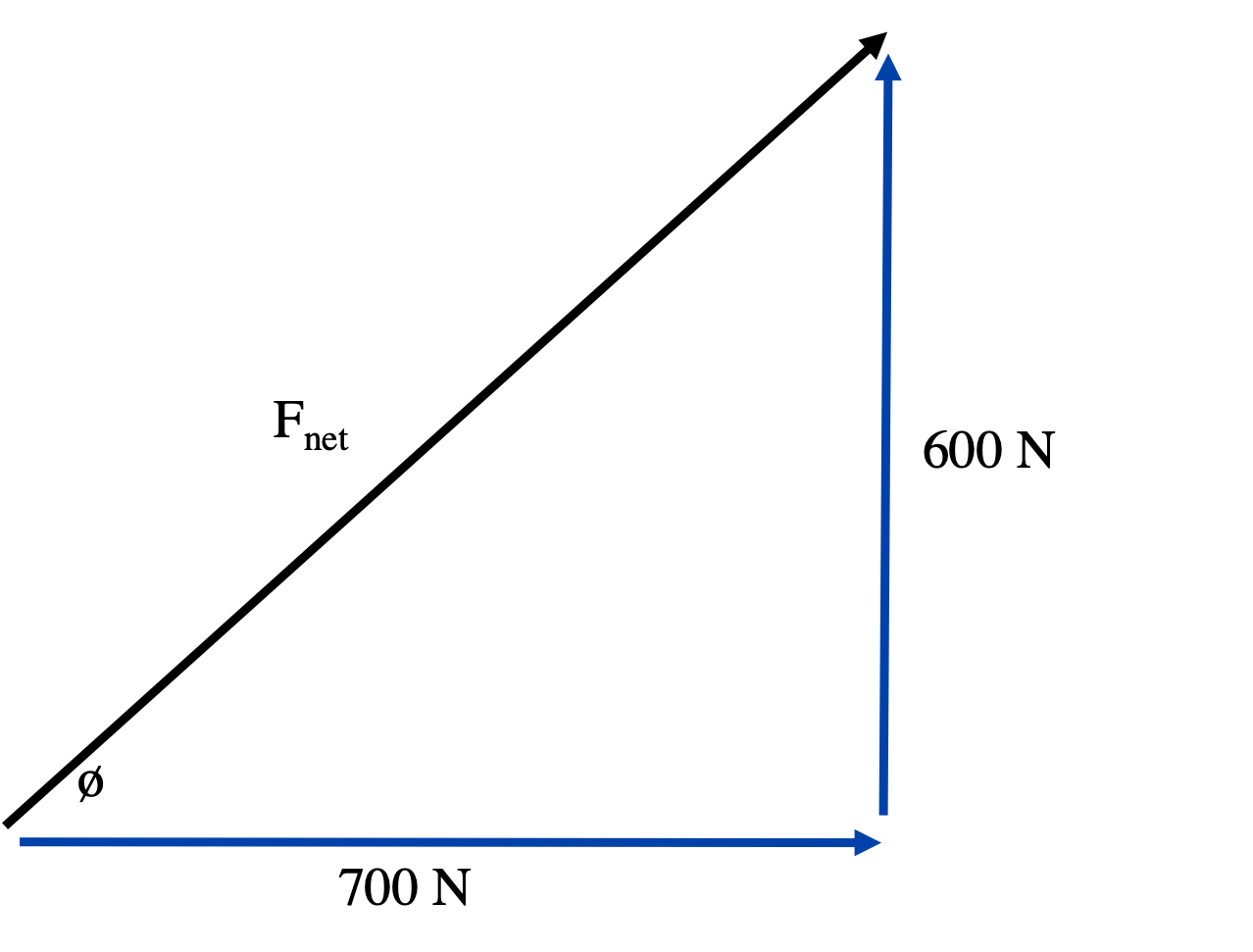
The magnitude of the net force is:
- [latex](F_{\text{net}})^2 = (600 \text{ N})^2 + (700 \text{ N})^2[/latex]
- [latex](F_{\text{net}})^2 = 360 000 \text{ N}^2 + 490000 \text{ N}^2[/latex]
- [latex](F_{\text{net}})^2 = 850000 \text{ N}^2[/latex]
- [latex]F_{\text{net}} = 922 \text{ N } (\approx 920 \text{ N})[/latex]
The angle this makes is:
- [latex]\tan ø = \dfrac{600 \text{ N}}{700 \text{ N}}[/latex]
- [latex]\tan ø = 0.8571[/latex]
- [latex]ø = \tan ^{-1} 0.8571[/latex]
- [latex]ø = 40.6^{\circ} (\approx 41^{\circ})[/latex]
The main purpose of this section is for you to be able to quickly resolve a vector with an angle into components.
Example 7.2.1
Resolve the following vectors and angles into components.
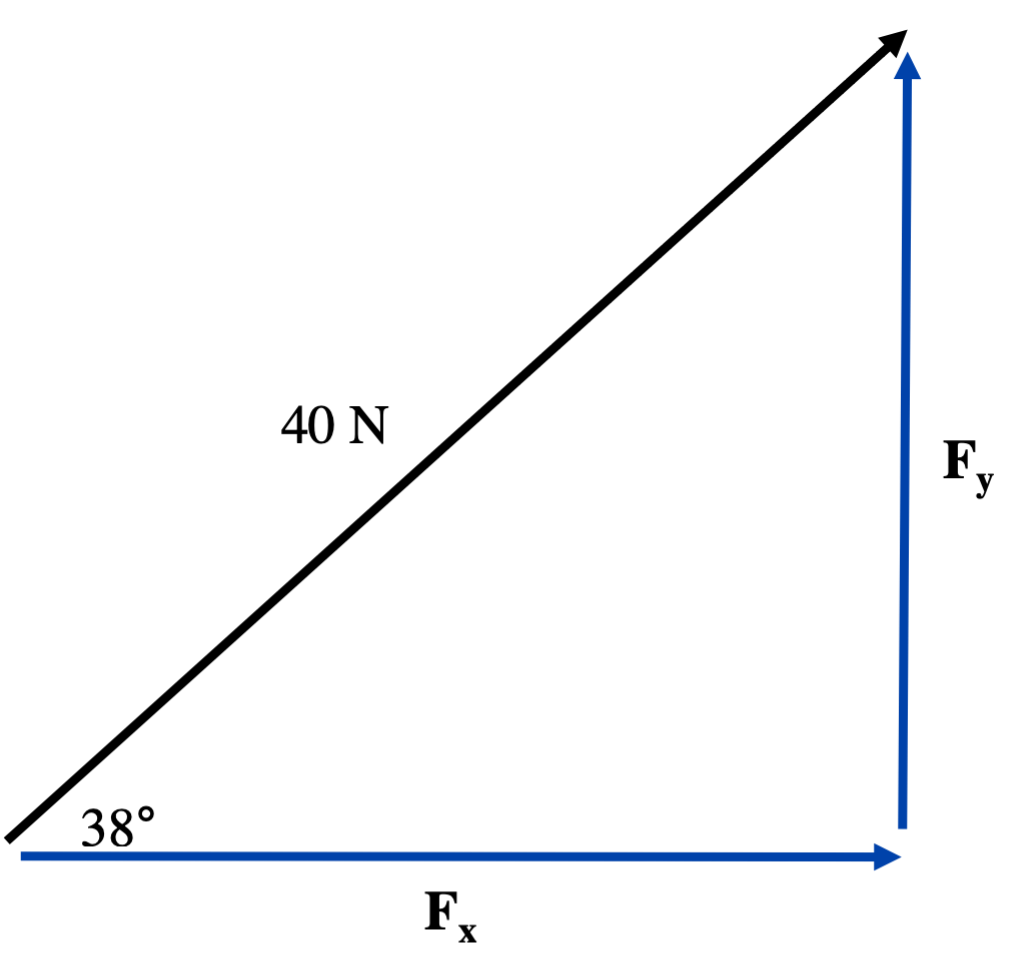
Solution
- [latex]F_y = 40 \text{ N } \sin 38^{\circ}[/latex] or 24.6° (≈ 25 N)
- [latex]F_x = 40 \text{ N } \cos 38^{\circ}[/latex] or 31.5° (≈ 32 N)
Example 7.2.2
Resolve the following vectors and angles into components.
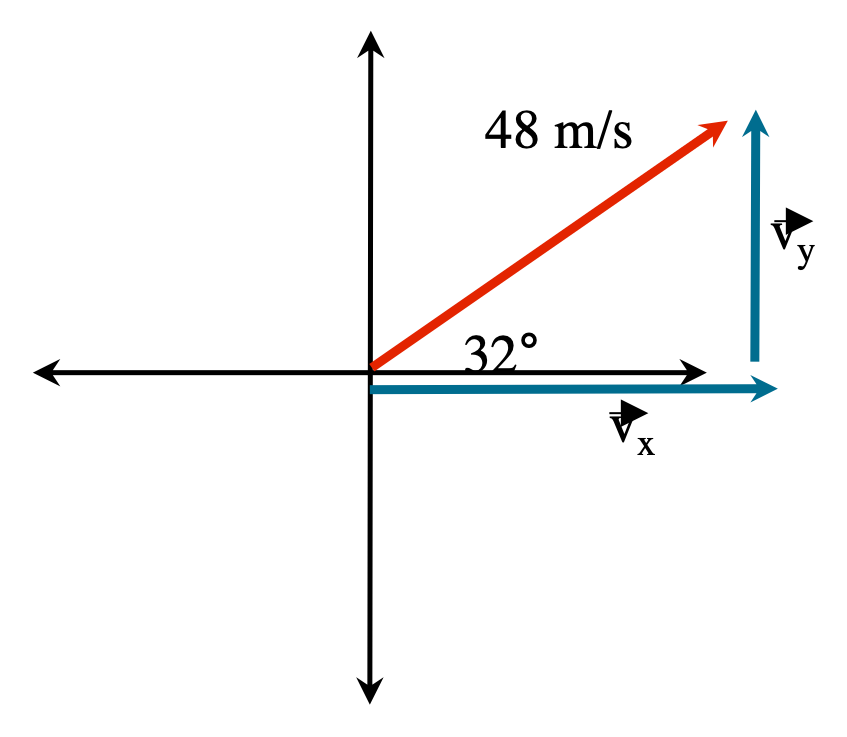
Solution
- [latex]\vec{v_y} = 48 \text{ m/s } \sin 32^{\circ}[/latex] or 25.4 m/s (≈ 25 m/s)
- [latex]\vec{v_x} = 48 \text{ m/s } \cos 32^{\circ}[/latex] or 40.7 m/s (≈ 41 m/s)
Example 7.2.3
Resolve the following vectors and angles into components.

Solution
- [latex]\vec{F_y} = 32 \text{ m/s } \sin 28^{\circ}[/latex] or 15 m/s
- [latex]\vec{F_x} = 32 \text{ m/s } \cos 28^{\circ}[/latex] or (−) 28 m/s
Example 7.2.4
Resolve the following vectors and angles into components.
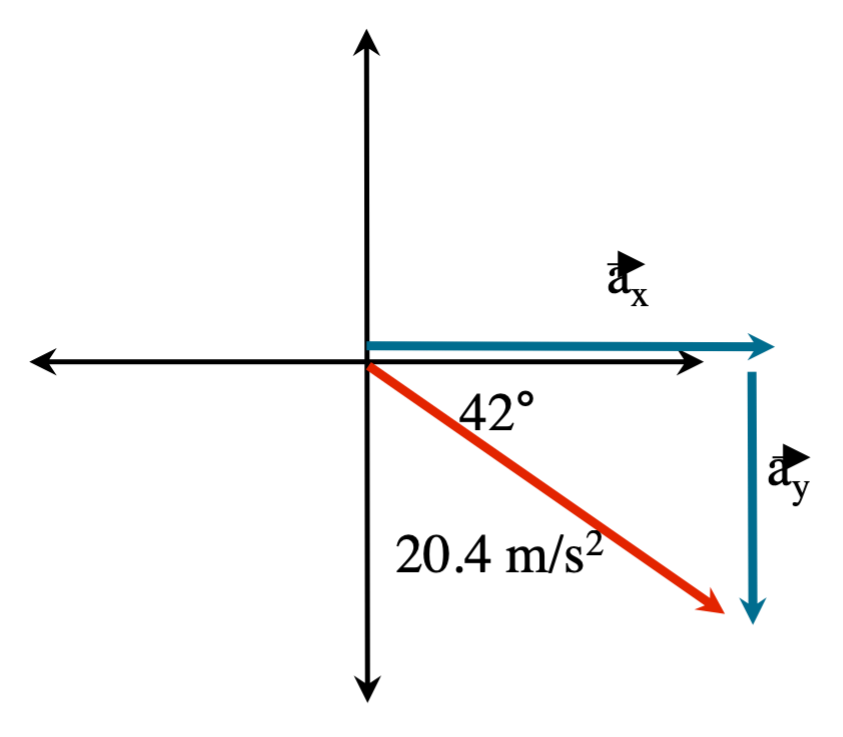
Solution
- [latex]\vec{a_y} = 20.4 \text{ m/s}^2 \text{ } \sin 42^{\circ}[/latex] or (−) 14 m/s2
- [latex]\vec{a_x} = 20.3 \text{ m/s}^2 \text{ } \cos 42^{\circ}[/latex] or 15 m/s2
Exercise 7.2
Break the following vectors into components (not drawn to scale)
7.3 Static Equilibrium (Concurrent Forces)
Static equilibrium is one of the requirements of architecture; engineering tools and techniques have been employed since ancient times to create buildings that are statically safe from collapse. In short, structural design must work to counteract the effects of gravity, storms and earthquakes, to name a few of the forces that can act on a structure.
 The bridge to the left was thought to have been built during the reign of Augustus (27 BCE- 14CE) as an aqueduct to supply water to the town of Tarraco in Catalonia, Spain. This structure, 249 m in length, is comprised of a series of free-standing stone arches that have the same radius of 5.9 ± 0.15 m. Of the 931 known Roman bridge structures surviving to date, the largest of these is the Puente Romano bridge in Merida, Spain, having a length of 792 m.
The bridge to the left was thought to have been built during the reign of Augustus (27 BCE- 14CE) as an aqueduct to supply water to the town of Tarraco in Catalonia, Spain. This structure, 249 m in length, is comprised of a series of free-standing stone arches that have the same radius of 5.9 ± 0.15 m. Of the 931 known Roman bridge structures surviving to date, the largest of these is the Puente Romano bridge in Merida, Spain, having a length of 792 m.
 The arch design used in Roman bridges is one that is found in nature, such as the Azure Window shown to the right and located in Malta. The success of the strength in the design of arch structures is due to the way in which the force from the weight of the bridge is carried outward along the curve of the arch, and is balanced by the supports anchoring either end.
The arch design used in Roman bridges is one that is found in nature, such as the Azure Window shown to the right and located in Malta. The success of the strength in the design of arch structures is due to the way in which the force from the weight of the bridge is carried outward along the curve of the arch, and is balanced by the supports anchoring either end.
 The flying buttress design generally known as a design favorite of the architects of the Notre Dame Cathedral consists of half arches placed on either side of the building to support the weight, and wind shears acting on the central dome covering the building. This technique of balancing forces allowed for the walls of the building to be opened up to allow windows to be constructed in the walls, to let in light and support the weight of the roof.
The flying buttress design generally known as a design favorite of the architects of the Notre Dame Cathedral consists of half arches placed on either side of the building to support the weight, and wind shears acting on the central dome covering the building. This technique of balancing forces allowed for the walls of the building to be opened up to allow windows to be constructed in the walls, to let in light and support the weight of the roof.
 The sketch shown to the right is that of Villard de Honnecourt (1225-1235). While of unknown purpose, it is part of a collection of works showing various designs of devices he saw during his travels through Medieval Europe.
The sketch shown to the right is that of Villard de Honnecourt (1225-1235). While of unknown purpose, it is part of a collection of works showing various designs of devices he saw during his travels through Medieval Europe.
**The images shown below illustrate the forces that act in an arch bridge: force vectors acting in the Action Force (Load) and the Reaction Force (Support for the Load).**
Conceptual Origins …
The term equilibrium[1] originates from the Latin “acqui” and “libra”, which mean “equal” and “balance”. When used in physics concepts, “objects in a state of equilibrium” refers to a balancing of forces acting on the object. This basic concept of equilibrium, i.e.: all forces acting on a point in an object sum to zero, is the embodiment of Newton’s first law.
To recall, Newton’s first law states that every object will remain at rest or in uniform motion in a straight line unless compelled to change its state by the action of an external force. This is normally taken as the definition of inertia. The key point here is that if there is no net force acting on an object (if all the external forces cancel each other out) then the object will maintain at a constant velocity. If that velocity is zero, then the object remains at rest. If an external force is applied, the velocity will change because of the force.
From the Latin version of Newton’s Principia, his first law reads as…
Lex I: Corpus omne perseverare in statu suo quiescendi vel movendi uniformiter in directum, nisi quatenus a viribus impressis cogitur statum illum mutare.
Translated to English, this reads:
Law I: Every body persists in its state of being at rest or of moving uniformly straight forward, except insofar as it is compelled to change its state by force impressed.
Newton then expands on his first law with:
Projectiles persevere in their motions, so far as they are not retarded by the resistance of the air, or impelled downwards by the force of gravity. A top, whose parts by their cohesion are perpetually drawn aside from rectilinear motion, does not cease its rotation, otherwise than as it is retarded by the air. The greater bodies of the planets and comets, meeting with less resistance in more free spaces, preserve their motions both progressive and circular for a much longer time.
One of the challenges to the interpretation of Newton’s laws is that he appears to have written them following the style of earlier Greek philosophers, such as Euclid. As such, historians have suggested that Newton’s first law is simply a natural deduction of his second law since there is nothing about frames of reference included in Newton’s writings.
Equilibrium is explored in three different ways in this chapter: translational, static and rotational, all relating to the balancing of forces that act on an object or a structure. Equilibrium is a very important concept, and you should encounter a number of different ways that explore equilibrium in specialized fields.
Translational equilibrium occurs when no net or resultant force is acting on an object. This means that the sum of all forces that are acting will equal 0 N. Newton’s first law interprets this to mean that if the object is at rest, it will remain at rest and if the object is in motion, it will remain in that exact state of motion.
Rotational equilibrium requires that the object is non-rotating. This necessitates that all forces causing it to rotate (torques) will sum to zero. Newton’s first law interprets this to mean that if the object is at rest, not-rotating, it will remain at rest and not-rotating. If the object is rotating, it will remain in that exact state of rotation, neither speeding up nor slowing down.
Static equilibrium is a special case of translational and rotational equilibrium, and occurs when the net force or resultant force acting on an object sums to zero and the object is neither moving in any direction nor rotating. Static equilibrium requires that the object in question is at rest and remains at rest.
When we look at the effect of forces acting on a body, there are five commonly observed actions. You will be encountering the first two of these, compression (C) and tension (T), in the problems in this chapter.
Free Body Diagrams
Free body diagrams are standard tools used to analyze forces in equilibrium. Free body diagrams are used to show the magnitude and direction of all forces that act on a body in a given situation. In many cases these diagrams are drawn to scale, with the length of the arrow in scale to the magnitude of the force and the angle of this force accurately positioned. Learning to draw a free body diagram is important for one to be able to work through questions in statics, dynamics and a few other fields of classical mechanics.
Using the free body diagram as a tool, one is able to easily visualize whether or not the forces acting on an object add to zero ([latex]F_{\text{net}} = 0[/latex]). If they do add to zero, the object is in static equilibrium and not moving. If the forces acting on the body do not add to zero ([latex]F_{\text{net}} \neq 0[/latex]), it will accelerate.
Hyper physics lists a number of common forces that you can encounter where free body diagrams assist in working out the intricacies of the problem. In Chapter 6, you encountered weight ([latex]w[/latex], [latex]F_g[/latex]) which is a force vector directed straight down towards the Earth’s centre. In Chapter 7 you will use another force vector called tension ([latex]T[/latex], [latex]F_t[/latex]). Tension is the force that exists in strings, cables, ropes or beams that are acting to apply a force to an external object. Tension for these are the forces transmitted by the cable, rope, string or beam and act in the direction these are pulling or pushing. In the simplest examples that follow, this tension balances the weight. The examples become more complicated when multiple tensions act on an external object.
Other common forces that you will encounter are:
- Normal force ([latex]N[/latex], [latex]F_n[/latex]), which can be explained as the force exerted by a surface tangentially away from the surface to support an object.
- Frictional force ([latex]f[/latex] , [latex]F_f[/latex]), which is the force acting between two surfaces, and is generally opposite to the direction the object is moving or accelerating, but this is not always true.
- Elastic forces ([latex]F_e[/latex], [latex]F_s[/latex]) are the forces exerted by springs or rubber bands, etc., when they are stretched (or compressed in some cases). The force in these instances acts in the direction of the stretch or compression.
- Buoyancy ([latex]B[/latex], [latex]F_b[/latex]) is the force that acts on objects that are immersed or suspended in a fluid. The direction of this force is always upwards and away from the centre of the Earth.
- Drag or air resistance ([latex]R[/latex], [latex]D[/latex], [latex]F_d[/latex], [latex]F_{\text{air}}[/latex]) is the force that acts on any object that is moving through a fluid, be it liquid or gaseous. This force will generally be acting opposite to the direction that the object is moving (opposite to the velocity).
- Lift ([latex]L[/latex], [latex]F_l[/latex]) is the force that acts on an object that is tangential to its movement through a fluid, meaning that as the object is moving forward through a fluid, the lift will act at 90° to the direction of the object’s velocity.
- Thrust ([latex]T[/latex], [latex]F_t[/latex]) is the action-reaction force that results from pushing a fluid in one direction (generally backwards) that allows the object doing this pushing to move in the opposite direction.
In all cases, combinations of the above forces can be acting on some object, requiring one to find the net result of forces ([latex]F_{\text{net}}[/latex]) acting on the object. All these forces are in newtons (N).
The following examples will illustrate how one can draw a free body diagram of the forces acting on a body.
Example 7.3.1
Consider a parachutist:
- First starts to fall

- Reaches terminal velocity

Example 7.3.2
Consider a person floating in a lake:

The principle used to draw these diagrams is the same when you encounter more than two forces acting on an object. Two cables supporting an object at rest or moving at a constant velocity ([latex]F_{\text{net}} = 0[/latex]) would show up as two forces acting in unison to balance the weight or force of gravity pulling down on the object. If these cables are acting to accelerate the object either up, down or to one side ([latex]F_{\text{net}} \neq 0[/latex]) then the forces acting on the object would show some imbalance. In all cases, the force arrows will act in the directions that the forces act on the object.
Example 7.3.3
Suppose you have a box suspended in air by two cables as shown below.
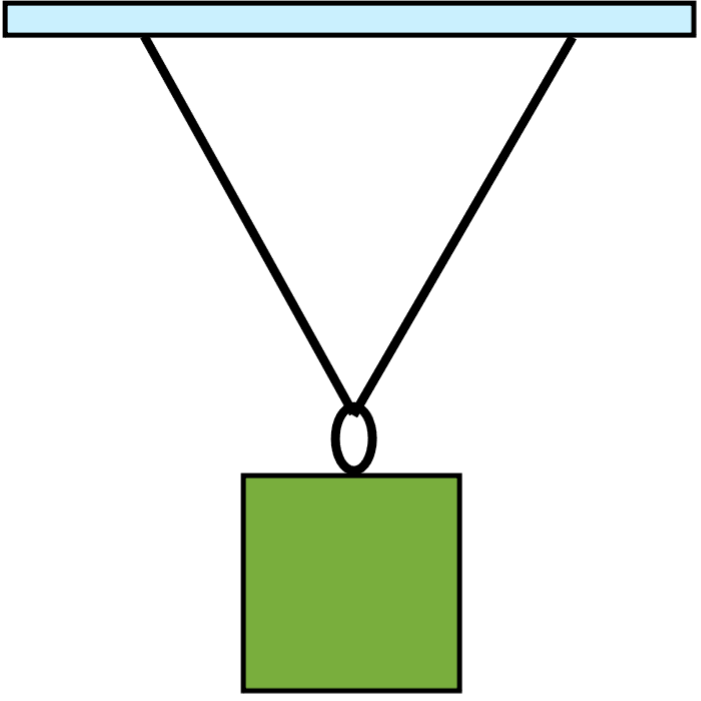
If we were to redraw this using force vectors, it would look like:

To properly analyze this diagram we would need both the magnitudes and directions of all forces acting on the box. (Forces are generally termed tensions when these forces are pulling on the cable. This is compared to a beam that can be experiencing a force that can be acting to compress it.)
This diagram to the right can be further reduced to:

Trigonometry would be used at this point to break the two Cable Tensions (T1 & T2) into vector components. The rest of the solution would be algebra in balancing the forces acting on the Box.
Example 7.3.4
Find the tension in a cable supporting a single box of 25 kg in Static Equilibrium.
Solution
The sketch and the free body diagrams for this example are:
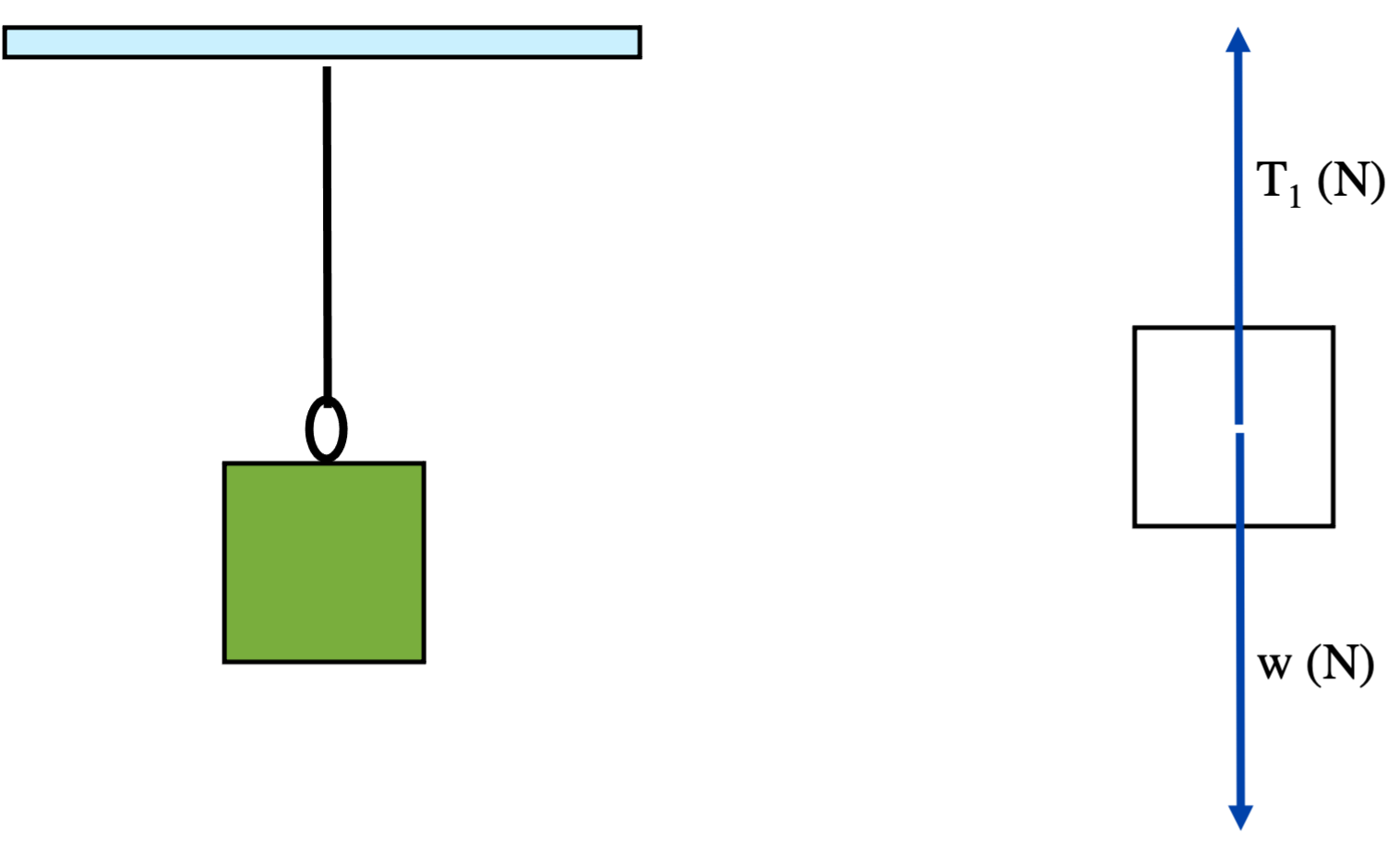
The solution for this requires that the forces acting on the box must sum to zero. In an equation this looks like:
[latex]\sum \vec{F_y} = 0 \text{ N}[/latex]
To solve this problem, assign cartesian directions as you would on a graph:
For y-direction, up is positive and down is negative and for the x-direction, right is positive and left is negative.
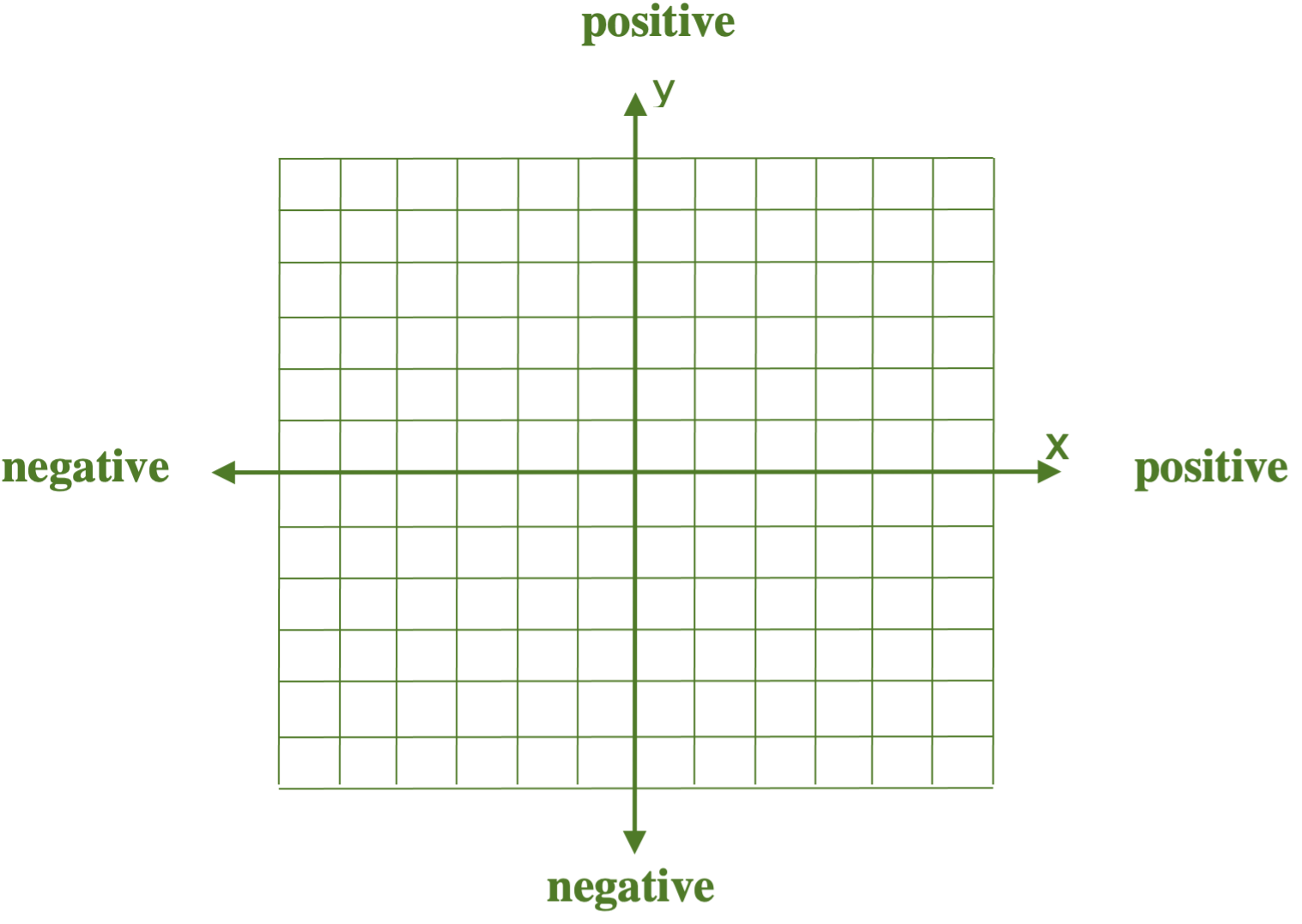
Using this vector notation, the solution is as follows:
- [latex]T_1 + w = 0 \text{ N}[/latex]
- [latex]T_1 + (25 \text{ kg})(- 9.8 \text{ m/s}^2) = 0 \text{ N}[/latex]
- [latex]T_1 - 245 \text{ N } = 0 \text{ N}[/latex]
- [latex]T_1 = 0 \text{ N } + 245 \text{ N}[/latex]
- [latex]T_1 = 245 \text{ N } (\approx 250 \text{ N})[/latex]
The direction of this force is upwards.
Example 7.3.5
Find the tension in the two cables supporting a single crate of 100 kg in static equilibrium as shown in the diagram below.
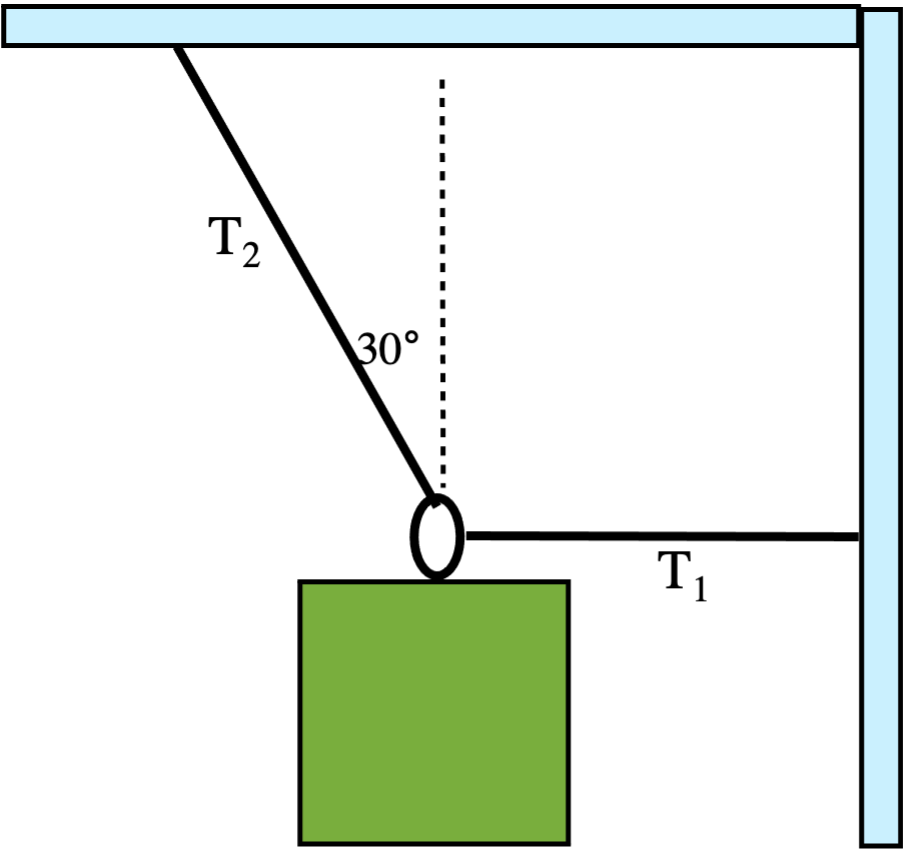
Solution
The free body diagram of this problem looks like:

These forces act in two directions… ± [latex]x[/latex] and ± [latex]y[/latex], and the solution for this requires balancing these forces in two directions.
[latex]\sum \vec{F_x} = 0 \text{ N}[/latex] and [latex]\sum \vec{F_y} = 0 \text{ N}[/latex]
[latex]\text{Weight }= (100 \text{ kg})(-9.8 \text{m/s}^2)[/latex] or [latex]-980 \text{ N}[/latex] in the y-direction.
Since cable 2 is the only cable supporting the crate, we know that the tension in the cable in the y-direction must be + 980 N. The sketch of this looks as follows:
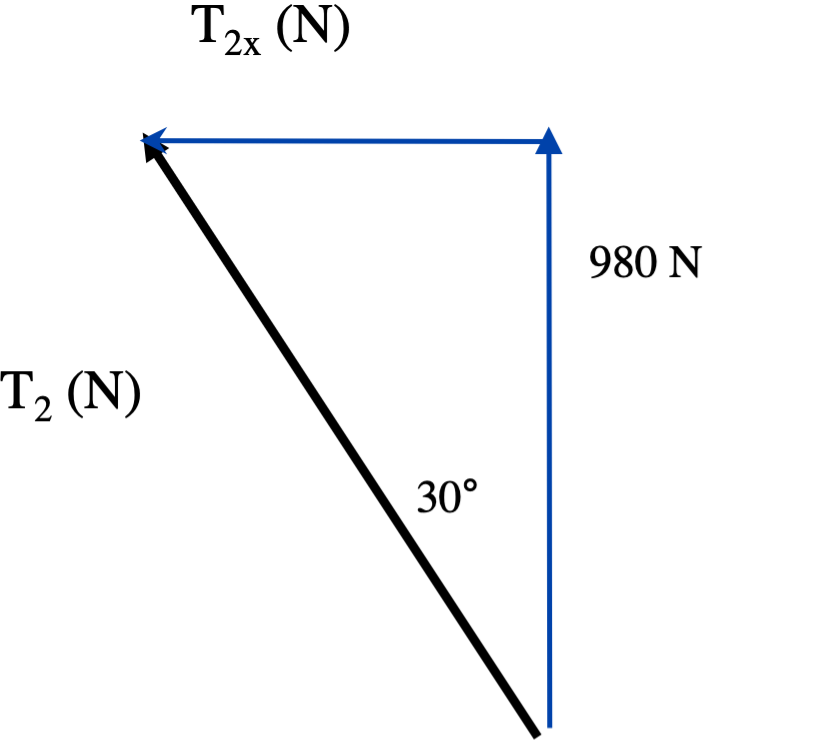
Trigonometry is now used to find the tension of cable 2 in the x direction ([latex]T_{2x}[/latex]):
- [latex]\tan 30^{\circ} = \dfrac{T_{2x}}{980 \text{ N}}[/latex]
- [latex]T_{2x} = 980 \text{ N } \tan 30^{\circ}[/latex]
- [latex]T_{2x} = -566 \text{ N } (\approx -570 \text{ N})[/latex], negative x direction.
Now, the total tension of cable 2 is:
- [latex]\cos 30^{\circ}= \dfrac{980 \text{ N}}{T_2}[/latex]
- [latex]T_2 = \dfrac{980 \text{ N}}{\cos 30^{\circ}}[/latex]
- [latex]T_2 = 1132 \text{ N } (\approx 1100 \text{ N})[/latex]
And, the tension of cable 1 is:
- [latex]T_1 = 566 \text{ N } (\approx 570 \text{ N})[/latex] (equal and opposite to [latex]T_{2x}[/latex])
Putting all of this in a free body diagram yields:

When summing up the forces [latex]\sum \vec{F_x} = 0 \text{ N}[/latex] and [latex]\sum \vec{F_y} = 0 \text{ N}[/latex]…
[latex]\sum \vec{F_x} = 0 \text{ N}[/latex]
- [latex]T_{2y} + w = 0 \text{ N}[/latex]
- [latex]980 \text{ N } - 980 \text{ N } = 0 \text{ N}[/latex]
[latex]\sum \vec{F_y} = 0 \text{ N}[/latex]
- [latex]T_{2x} + T_1 = 0 \text{ N}[/latex]
- [latex]-566 \text{ N } + 566 \text{ N } = 0 \text{ N}[/latex]
Example 7.3.6
Find the tension in the two cables supporting a single box of 420 kg in static equilibrium as shown in the diagram below and to the right.
.
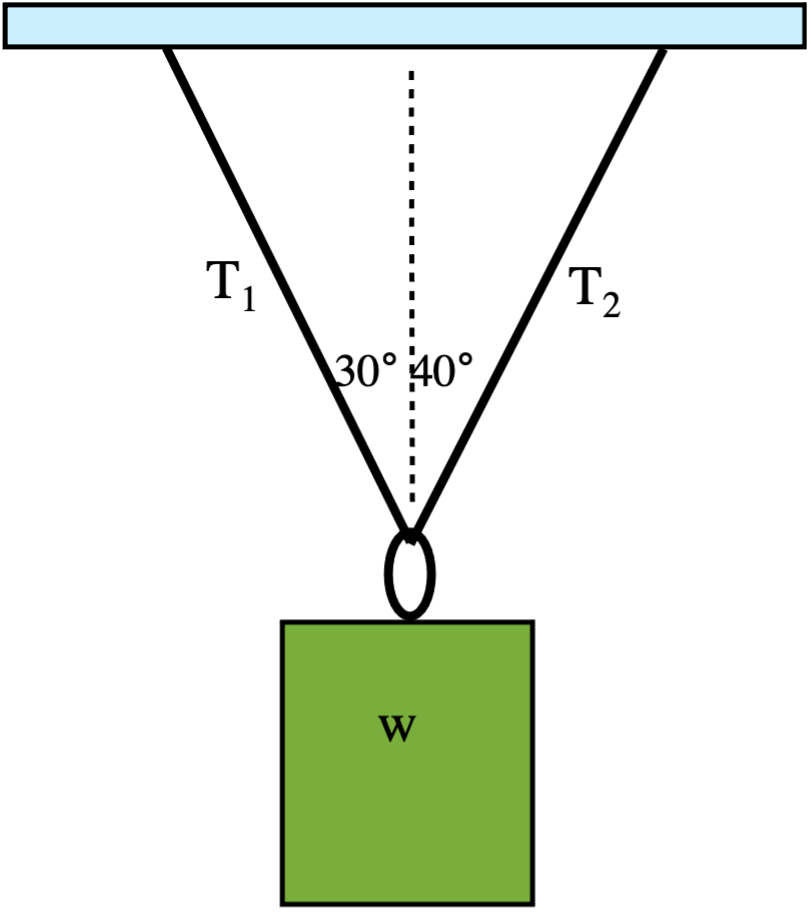
Solution
The free body diagram for this problem looks like:

Solving this problem is a little more work.
First, the weight is:
- [latex]w = m g[/latex]
- [latex]w = (420 \text{ kg})(9.8 \text{ m/s}^2)[/latex]
- [latex]w = 4116 \text{ N } (\approx 4100 \text{ N})[/latex]
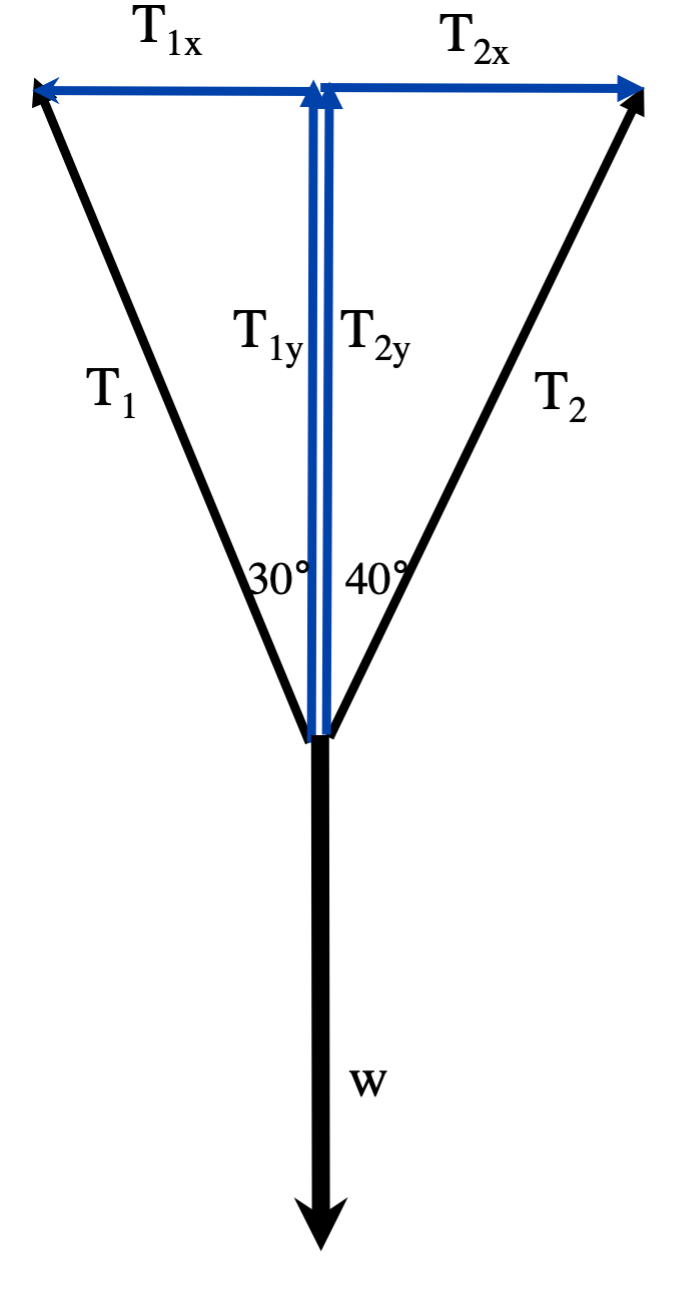
Summing up the forces acting on the box:
- In the y direction: [latex]T_{1y} + T_{2y} + w = 0 \text{ N}[/latex]
- In the x direction: [latex]T_{1x} + T_{2x} = 0 \text{ N}[/latex]
Find what we know about the Tensions.
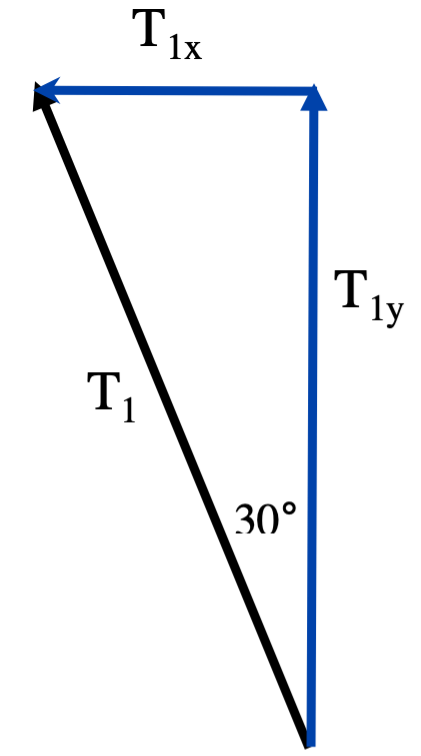
[latex]\sin 30^{\circ} = T_{1x} \div T_1[/latex], or…
- [latex]T_{1x} = T_1 \sin 30^{\circ}[/latex]
- [latex]T_{1x} = 0.500 T_2[/latex]
[latex]\cos 30^{\circ} = T_{1y} \div T_1[/latex], or…
- [latex]T_{1y} = T_1 \cos 30^{\circ}[/latex]
- [latex]T_{1y} = 0.866 T_1[/latex]

[latex]\sin 40^{\circ} = T_{2x} \div T_2[/latex], or…
- [latex]T_{2x} = T_2 \sin 40^{\circ}[/latex]
- [latex]T_{2x} = 0.643 T_2[/latex]
[latex]\cos 40^{\circ} = T_{2y} \div T_2[/latex], or…
- [latex]T_{2y} = T_2 \cos 40^{\circ}[/latex]
- [latex]T_{2y} = 0.766 T_2[/latex]
Balancing all forces:
- x direction: [latex]0 \text{ N } = T_{1x} + T_{2x}[/latex] or [latex]0 \text{ N } = 0.500 T_1 - 0.643 T_2[/latex]
- y direction: [latex]0 \text{ N } = T_{1y} + T_{2y} + w[/latex] or [latex]0.866 T_1 + 0.766 T_2 = 4116 \text{ N}[/latex]
Now, use substitution to solve this system of two equations.
First: Isolate [latex]T_1[/latex]
- [latex]0 \text{ N } = 0.643 T_1 - 0.500 T_2[/latex]
- [latex]0.500 T_1 = 0.643 T_2[/latex]
- [latex]T_1 = \dfrac{0.643 T_2}{0.500}[/latex]
- [latex]T_ 1 = 1.29 T_2[/latex]
Second: Substitute for [latex]T_2[/latex]
- [latex]0.866 T_1 + 0.766 T_2 = 4116 \text{ N}[/latex]
- [latex]0.866 (1.29 T_2) + 0.766 T_2 = 4116 \text{ N}[/latex]
- [latex]1.12 T_{2} + 0.766 T_{2} = 4116 \text{ N}[/latex]
- [latex]1.866 T_2 = 4116 \text{ N}[/latex]
- [latex]T_2 = 4116 \text{ N } \div 1.462 \text{ or } 2182 \text{ N } (\approx 2200 \text{ N})[/latex]
Finally:
- [latex]T_1 = 1.29 T_2[/latex]
- [latex]T_1 = (1.29)(2182 \text{ N})[/latex]
- [latex]T_1 = 2815 \text{ N } (\approx 2800 \text{ N})[/latex]
Example 7.3.7
Find the tension in the cable and the reactive force from the beam supporting a single crate of 500 kg in static equilibrium as shown in the diagram below.
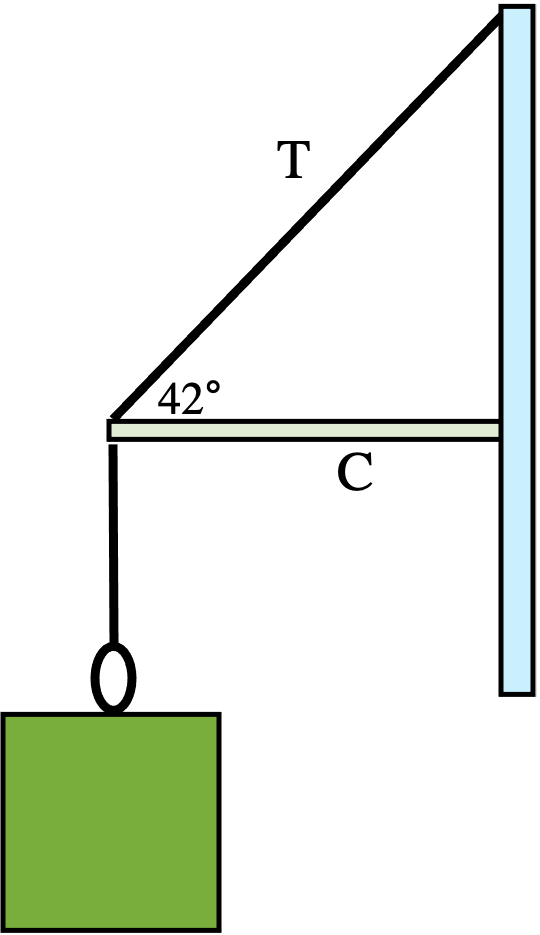
Solution
[latex]\text{Weight } = (500 \text{ kg})(- 9.8 \text{ m/s}^2) or -4900 \text{ N}[/latex]
Conditions for equilibrium:
[latex]\sum \vec{F_x} = 0 \text{ N}[/latex] or [latex]\sum \vec{F_y} = 0 \text{ N}[/latex]
Since this cable is the only force supporting the crate, we know that the tension in the cable in the y-direction must be + 4900 N.
- [latex]T_y = + 4900 \text{ N}[/latex]
Trigonometry is now used to find the tension of the cable in the x direction ([latex]T_x[/latex]).
- [latex]\tan 42^{\circ} = \dfrac{4900 \text{ N}}{T_x}[/latex]
- [latex]T_x = \dfrac{4900 \text{ N}}{\tan 42^{\circ}}[/latex]
- [latex]T_x = 5442 \text{ N } (\approx 5400 \text{ N})[/latex]… positive X-direction.
Now, the total tension of the cable is:
- [latex]\sin 41^{\circ} = \dfrac{4900 \text{ N}}{T}[/latex]
- [latex]T = \dfrac{4900 \text{ N}}{\sin 42^{\circ}}[/latex]
- [latex]T = 7323 \text{ N } (\approx 7300 \text{ N})[/latex]

The reactive force from the beam is:
- [latex]C = -5442 \text{ N } (\approx - 5400 \text{ N})[/latex] (equal and opposite to [latex]T_x[/latex])
Exercise 7.3
- Find the tension in a cable supporting a single box of 100 kg in static equilibrium.

- Find the tension in a cable supporting a single box weighing 5.0 N in static equilibrium.

- Find the tension in the two cables supporting a single crate of mass 50 kg in static equilibrium as shown in the diagram below to the right.
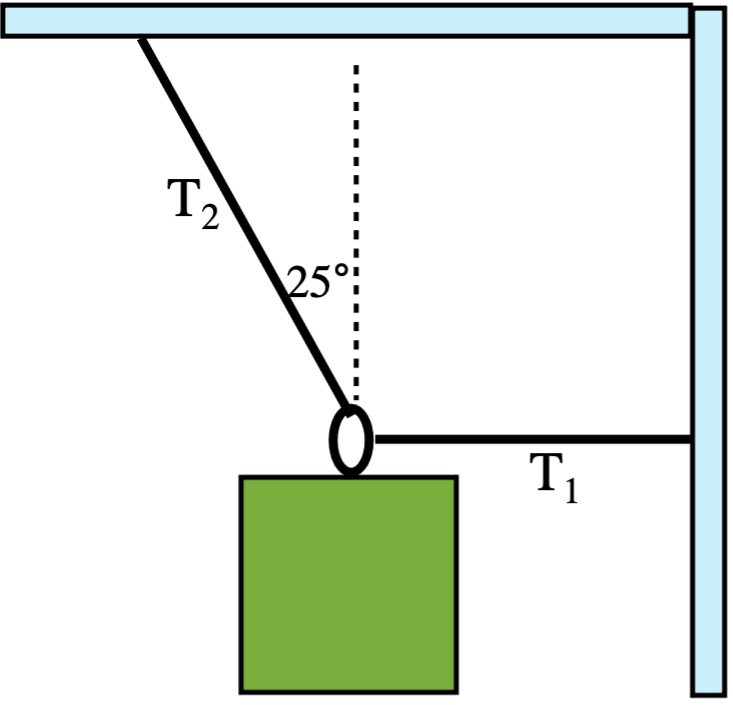
- Find the tension in the two cables supporting a single crate of 250 kg in static equilibrium as shown in the diagram below to the right.
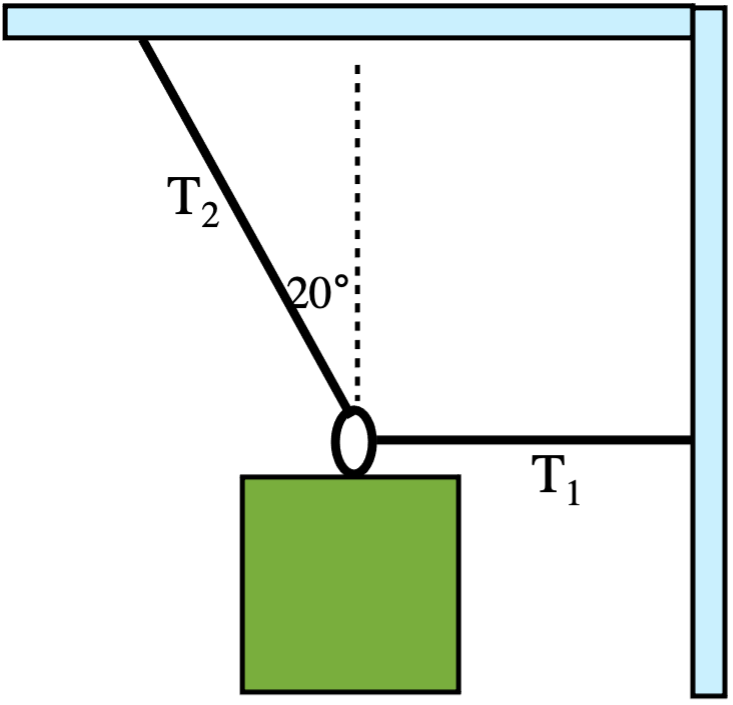
- Find the tension in the two cables supporting a single crate of 120 kg in static equilibrium as shown in the diagram below and to the right.
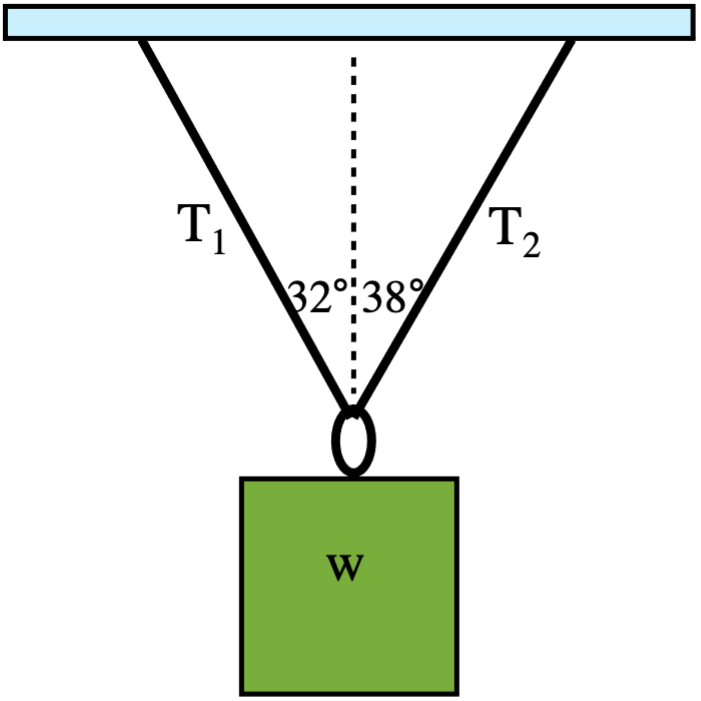
- Find the tension in the two cables supporting a single crate of 1200 kg in static equilibrium as shown in the diagram below and to the right.
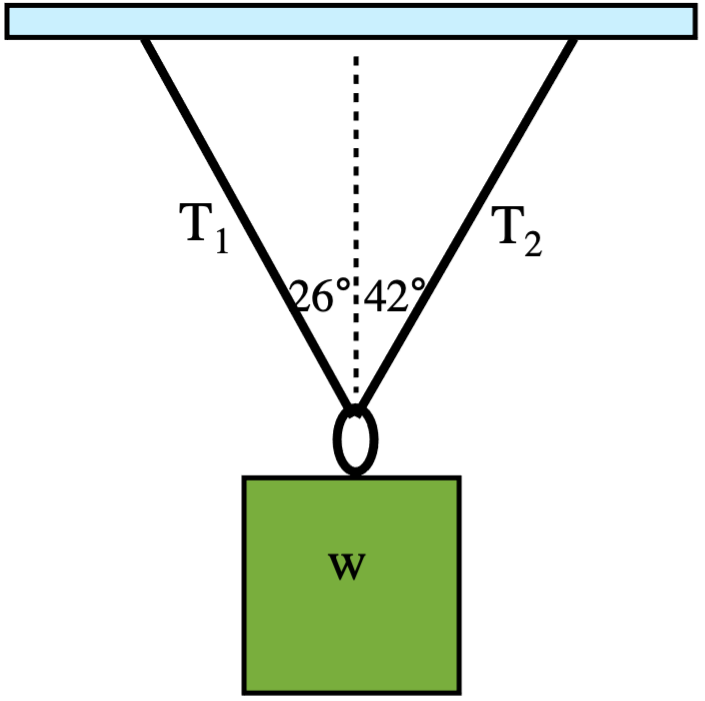
- Find the tension in the cable and the reactive force from the beam supporting a single crate of 420 kg in static equilibrium as shown in the diagram below to the right.
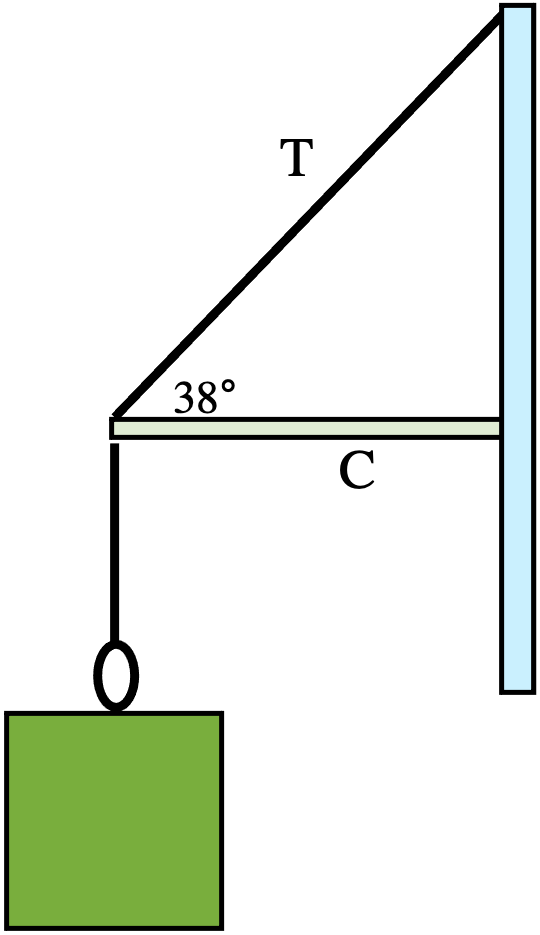
- If the maximum recommended tension in the cable is 12 000 N, find the reactive force from the beam that would be needed to support this maximum in static equilibrium as shown in the diagram below to the right.
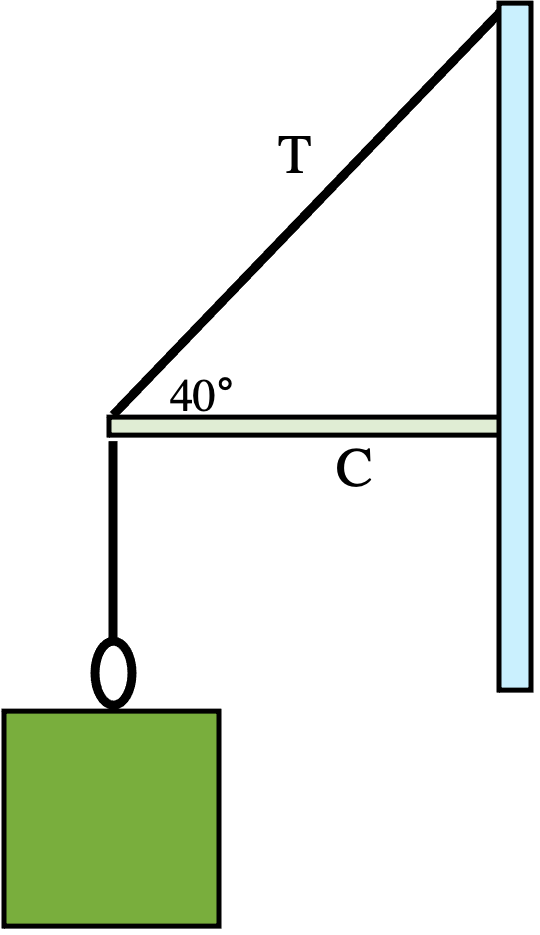
Exercise 7.4: Limits of a cable
A cable that has a maximum load tension of 50 000 N is slowly lifting a heavy crate straight upwards.
- How close to the top can the crate be safely lifted?
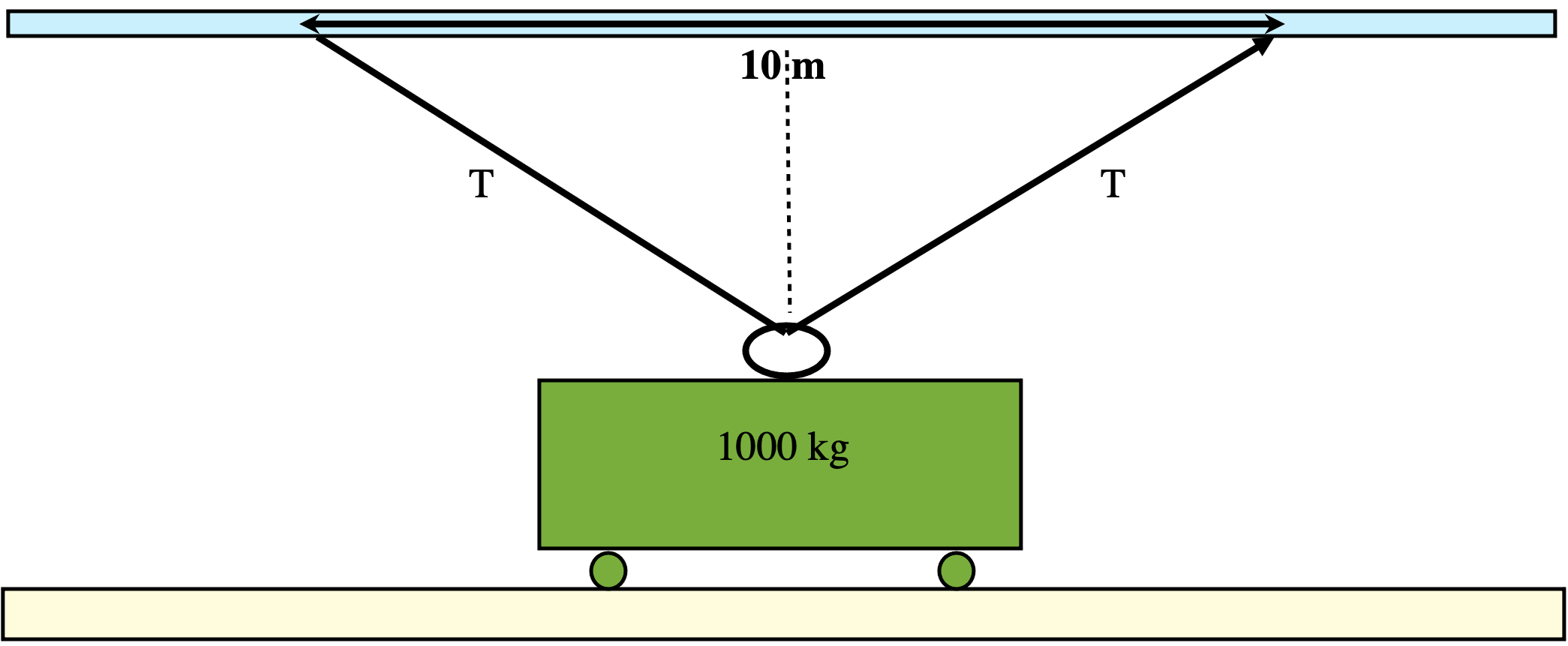
- What is the mass that can be lifted to within 10 cm from the top?
Exercise Answers
7.1 Right Angle Trigonometric Functions
- 0.743145
- 0.484810
- 0.906308
- 0.484810
- 0.194380
- 1.53986
- 0.190810
- 0.544639
- 29°
- 39°
- 50°
- 52°
- 33.3°
- 8.9°
- 41.0°
- 81°
- z = 27.36 (≈ 27), ø = 26.6° (≈ 27°)
- y = 19.6 (≈ 20), ø = 44.4° (≈ 44°)
- x = 16, ø = 53.1° (≈ 53°)
- x = 21.2 (≈ 21), y = 13.2 (≈ 13)
- x = 892 (≈ 890), y = 803 (≈ 800)
- z = 242 (≈ 240), ø = 24.4° (≈ 24°)
- x = 9.8, y = 6.9
- x = 37.6 (≈ 38), y = 42.6 (≈ 43)
- z = 25, ø = 53.1° (≈ 53°)
- y = 75, ø = 36.9° (37°)
- y = 4, ø = 53.1° (≈ 53°)
- y = 11.1 (≈ 11), z = 27.4 (≈ 27)
- z = 28.6 (≈ 29), ø = 44.4° (≈ 44°)
- y = 19.6 (≈ 20), ø = 44.4° (≈ 44°)
- y = 8.9, ø = 41.8° (≈ 42°)
- x = 35, y = 61
7.2 Vector Resolution into Components
- [latex]v_y[/latex] = 25.4 (≈ 25), [latex]v_x[/latex] = 40.7 (≈ 41)
- [latex]v_y[/latex] = 11, [latex]v_x[/latex] = 19.1 (≈ 19)
- [latex]F_y[/latex] = 15, [latex]F_x[/latex] = 28.3 (≈ 28)
- [latex]F_y[/latex] = 53.7 (≈ 54), [latex]F_x[/latex] = 79.6 (≈ 80)
- [latex]a_y[/latex] = 13.6, [latex]a_x[/latex] = 15.2
- [latex]a_y[/latex] = 22.0, [latex]a_x[/latex] = 45.1
- [latex]v_y[/latex] = 25.4 (≈ 25), [latex]v_x[/latex] = 40.7 (≈ 41)
- [latex]v_y[/latex] = 11, [latex]v_x[/latex] = 19.1 (≈ 19)
- [latex]F_y[/latex] = 15, [latex]F_x[/latex] = 28.3 (≈ 28)
- [latex]F_y[/latex] = 53.7 (≈ 54), [latex]F_x[/latex] = 79.6 (≈ 80)
- [latex]a_y[/latex] = 13.6, [latex]a_x[/latex] = 15.2
- [latex]a_y[/latex] = 22.0, [latex]a_x[/latex] = 45.1
7.3 Static Equilibrium (Concurrent Forces)
- [latex]T_y[/latex] = 980 N
- [latex]T_y[/latex] = 5.0 N
- [latex]T_1[/latex] = 228 N (≈ 230 N), [latex]T_2[/latex] = 541 N (≈ 540 N)
- [latex]T_1[/latex] = 89.2 N (≈ 89 N), [latex]T_2[/latex] = 261 N (≈ 260 N)
- [latex]T_1[/latex] = 769 N (≈ 770 N), [latex]T_2[/latex] = 663 N (≈ 660 N)
- [latex]T_1[/latex] = 8502 N (≈ 8500 N), [latex]T_2[/latex] = 5557 N (≈ 5600 N)
- T = 6685 N ( ≈ 6700 N), [latex]F_C = -5268[/latex] N (≈ [latex]- 5300[/latex] N)
- [latex]FC = - 14300[/latex] N (≈ [latex]- 14000[/latex] N)
7.4 Limits of a Cable
- distance = 0.49 m from the top
- [latex]m = 204 \text{ kg } = 200\text{ kg}[/latex]
Media Attributions
- “Observatory in Alexandria at the Time of Hipparchus” Hermann Goll is in the public domain.
- “Acueducto de Tarragona” by calafellvalo is licensed under a CC BY-NC-ND 2.0 licence.
- “Azure Window New” by anjab1593 is licensed under a CC BY 3.0 Unported licence.
- “Notre Dame buttress” by Jean Lemoine is licensed under a CC BY-SA 2.0 licence.
- “Villard Buttress Reims” uploaded by Wetman is in the public domain.
- Equilibrium is further classified as being stable, neutral or unstable. ↵

